
Introduction
There's been a bit of
a dilemma for buyers in recent years. Do you prioritise Ultra HD (3840 x 2160, aka "4K")
resolution for the sharpest possible image and highest level of detail, or
prioritise high refresh rates for the smoothest and fastest gaming experience.
Since the first prototype was shown off
at Computex in June 2016 (yes, over 2 years ago) there has been a massive
amount of hype, anticipation and excitement about a couple of new displays which
would be the first in the market to combine 4K resolution with a high 144Hz
refresh rate. In August this year we looked at one of the first models to
emerge, the
Asus ROG Swift PG27UQ. There was also an equivalent model released by Acer
with the same features, specs and panel which is their Predator X27.
As well as offering 4K @
144Hz,
the 27” panel being talked about here is IPS-type in technology, using an AU Optronics AHVA panel for
great all round performance and all the benefits of IPS technology that are well
established in the market. It's designed as a gaming screen, but it's not
limited in other areas like many TN Film gaming screens are. It offers support
for refresh rates up to 144Hz for super-smooth game play, high frame rate
support and improved motion clarity. To achieve this, it makes use of the latest
DisplayPort 1.4 interface which can support the necessary bandwidth beyond what
older DP 1.2 interfaces could manage.
The first wave of 4K
@ 144Hz screens like the Asus ROG Swift PG27UQ and Acer Predator X27 featured the latest NVIDIA G-sync HDR chip which supports the
variable refresh rate we know and love. Something that will be extremely important
given the high system and graphics card demands of this resolution and refresh
rate combination. This new chip also offers top-end LCD
High Dynamic Range (HDR) capabilities thanks to a 384-zone Full Array Local
Dimming (FALD) backlight system. This can offer superior HDR experience compared
with more limited edge-lit local dimming, and allows for high-end specs like a
1000 cd/m2 peak brightness. A wide colour space for HDR is supported through an
added Quantum Dot film coating, offering coverage for the DCI-P3 colour space
along with 10-bit colour depth. Thanks to all these high end HDR features, the
X27 and PG27UQ displays carry the
VESA DisplayHDR 1000 and
Ultra HD Premium certifications for HDR performance.
Those initial screens may seem like dream
specs for many users, but weren't without a major concern to many people - the
retail price. At around £2000 / $2000 they are not cheap, and this has put them
in a fairly small niche for those who are willing to fork out this much money
for a display, or who want super-high end, cutting edge technology and are
willing to pay for the privilege.
To combat this, Acer are now the first to offer an
alternative for 4K @ 144Hz gaming, but at a significantly reduced price. Their
new Nitro XV273K and Predator XB273K will offer the same 27" sized, 4K
resolution, 144Hz IPS-type panel, but will cut back on some of the
expensive and complicated FALD HDR features of the earlier Asus PG27UQ and Acer X27
models. This allows them to offer a more affordable monitor choice for those who
don't necessarily want or need the HDR support, but want a high refresh, high
resolution display still. The Nitro XV273K (reviewed here) is a model with AMD
FreeSync support, and will actually be the first model to offer 4K @ 144Hz with FreeSync.
The forthcoming XB273K will feature NVIDIA G-sync like the X27, but without the
FALD HDR backlight. The expected retail prices are $899 and $1299 USD
respectively according to the initial press releases. Certainly more affordable
than the top-end HDR capable X27 display. The new XV273K isn't just aimed at
gamers either, and there are a range of added extras like a factory calibration,
shading hood and ambient light sensor which aren't typically included on
gamer-orientated displays.
Note: We are going to
refer to the resolution of this screen during this review as 4K in places. We
know it's technically called 'Ultra HD' but the term 4K is so widely used and
frankly, easier to keep referring to.

|
Check Pricing and Buy -
Affiliate Links
|
|
Amazon
|
|
TFTCentral is a participant
in the Amazon Services LLC Associates Programme, an affiliate
advertising programme designed to provide a means for sites to earn
advertising fees by advertising and linking to Amazon.com, Amazon.co.uk,
Amazon.de, Amazon.ca and other Amazon stores worldwide. We also
participate in a similar scheme for Overclockers.co.uk. |

Specifications and
Features
The following table gives detailed
information about the specs of the screen as advertised:
|
Monitor
Specifications |
|
Size |
27" (68.4cm) |
Panel Coating |
Light AG coating |
|
Aspect
Ratio |
16:9 format, flat |
Interfaces |
2x
DisplayPort 1.4
2x HDMI 2.0
|
|
Resolution |
3840 x 2160 |
|
Pixel Pitch |
0.155mm (163 PPI) |
Design
colour |
Black bezel and monitor arm, with silver stand feet |
|
Response Time |
4ms G2G
1ms (with VRB strobed backlight) |
Ergonomics |
Tilt, 100mm height, swivel |
|
Static Contrast Ratio |
1000:1 |
|
Dynamic Contrast Ratio |
100 million:1 |
VESA Compatible |
Yes 100 x 100 |
|
Brightness |
400 cd/m2 |
Accessories |
2x DisplayPort and USB cables. Power cable and brick,
shading hood |
|
Viewing Angles |
178 / 178 |
|
Panel Technology |
AU Optronics AHVA
(IPS-type) |
Weight |
net: 6.59 Kg |
|
Backlight Technology |
W-LED with Quantum Dot |
Physical Dimensions |
(WxHxD) with stand
629 x 441 - 541 x 307.2mm |
|
Colour Depth |
1.07b (8-bit+FRC) |
|
Refresh Rate |
120Hz native maximum
144Hz using 2x DP connections
60Hz over HDMI |
Special
Features |
3.5mm Headphone jack, 2x 4W
speakers, factory calibration report, VESA Display HDR 400, AMD FreeSync,
4x USB 3.0 hub, shading hood, blur reduction backlight (VRB),
ambient light sensor, coloured lighting system |
|
Colour
Gamut |
Specified extended gamut up to 90%
DCI-P3 (~125% sRGB) |
The XV273K offers a good range of
modern connectivity options. This includes two of the latest generation of DisplayPort 1.4
connection which allows support for the very
high bandwidth needed to power the screen at 3840 x 2160 @ 144Hz and with HDR.
Connection via a single DP 1.4 port can support the screen at 3840 x 2160 @ 120Hz, but you
need to use both of them at the same time from compatible graphics cards to
reach the full 144Hz refresh rate. We will talk a lot more about that
later on.
There are also 2x HDMI 2.0 for connection of external devices like games consoles
(60Hz maximum). All the ports support HDCP 2.2 and can handle HDR content,
so you can use HDR from your PC as well as compatible games consoles and Ultra
HD Blu-ray players. In the box are 2x DisplayPort cables, but no HDMI cable.
Some regions may ship with an HDMI cable included perhaps, but check if it's
something you need.
There is an additional 4 port USB 3.0 hub, with
two of the ports located
on the back of the screen, and two of them on the left hand side for easy
access. There is a headphone jack too and the screen includes 2x 4W stereo
speakers. The screen has an external power supply and comes
packaged with the power cable and brick you need.
There are a few extra features including a
colourful ambient lighting system, light sensor for automatically adjusting the
screens brightness, a bundled shading hood and an added motion blur reduction
backlight. We will talk about these later on in the review.
Below is a summary of the features and
connections of the screen:
|
Feature |
Yes / No |
Feature |
Yes / No |
|
Tilt adjust |
 |
DVI |
 |
|
Height adjust |
 |
HDMI |
 |
|
Swivel adjust |
 |
D-sub |
 |
|
Rotate adjust |
 |
DisplayPort |
 |
|
VESA compliant |
 |
Component |
 |
|
USB 2.0 Ports |
 |
Audio connection |
 |
|
USB 3.0 Ports |
 |
HDCP Support |
 |
|
Card Reader |
 |
MHL Support |
 |
|
Ambient Light Sensor |
 |
Integrated Speakers |
 |
|
Human Motion Sensor |
 |
PiP / PbP |
 |
|
Touch Screen |
 |
Blur Reduction Mode |
 |
|
Factory calibration |
 |
G-Sync |
 |
|
Hardware calibration |
 |
FreeSync |
 |
|
Uniformity correction |
 |
Wireless charging |
 |

Design and
Ergonomics
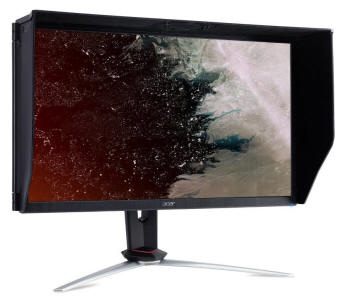
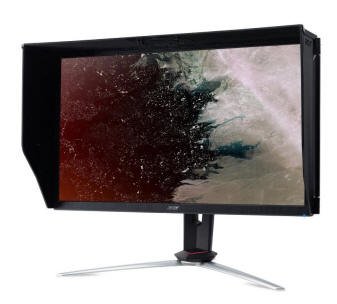
Above: front view of the screen. Click for larger version
The XV273K comes in a mostly black design,
with matte black plastics used for the front bezels, monitor arm and rear
enclosure. This model is not a zero-frame design, as there is not currently a
borderless version of this 4K @ 144Hz panel produced, so it has normal bezels
around all 4 sides. These are moderately thick, measuring around 15mm along the
sides and top and about 22mm along the bottom edge. The bottom edge has a subtle
vertical line etched pattern on it but it's hard to notice in normal use. There is a
shiny Acer logo in the middle of the bottom bezel, and a small blue power LED in
the bottom right hand corner but no other writing or labels on the front of the
display.
The monitor arm is also a matte black plastic
finish with a cable tidy hole in the back. At the base of this where it attaches
to the foot of the stand there is a small section of red trim, and then the foot
is made of a light silver coloured metal. This provides a wide and sturdy base
for the screen.
The images included here are all with the
shading hood attached. This comes in the box separately and can of course be
removed. These aren't often provided with gaming displays, although we've seen
some models from BenQ with a bundled hood in the past. It's designed to help
reduce distractions for gaming and allow you to focus on the screen and action
more closely. They are sometimes also included for
professional grade screens to help reduce glare and external light sources from
disrupting the image. We're undecided whether it's of much use to the
masses here for gaming, but some people may like it.
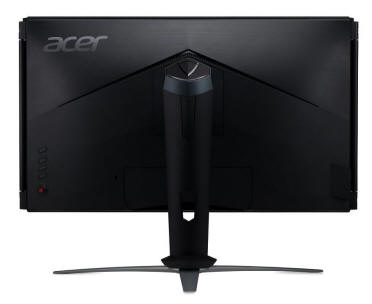
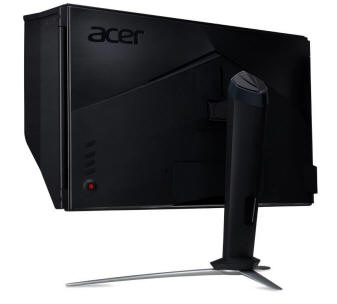
Above: rear views of the screen. Click for larger versions
The back of the screen is encased in a matte
black plastic as shown above. There is a large Acer logo in the top left corner
and some air vents above where the stand attaches. The monitor arm is attached
to the screen when you unpack it, but you need to screw in the foot to the base.
There are no visible screws but you can clip
out a couple of small plastic sections on the back to reveal these, and
it's possible to remove the arm if you want to VESA 100mm mount the display
instead.
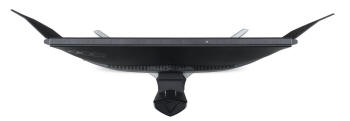
Above: view from above. Click for larger version
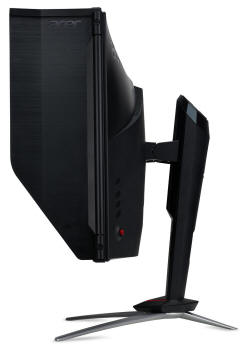
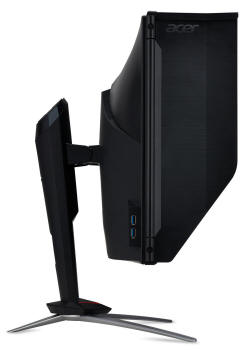
Above: side views of the screen (with shading hood attached). Click for
larger versions
One other good thing to note is that because
this model does not feature a
Full Array Local Dimming (FALD) Backlight system for HDR content, it has a
thinner profile than models like the Asus PG27UQ and Acer X27. It also does not
need the active cooling fan that those FALD models included, as the backlight
does not get as hot. The small fan included to help keep those previous models
cool was a gripe of many potential buyers, and so they will be pleased to see it
is not needed here.
You will see the OSD control buttons and
joystick located on the back of the screen, on the left hand side when viewed
from behind. There is a power on/off button at the top, 3 control buttons and
then a useful joystick for navigation. You will also see the additional 2x USB
3.0 ports located on the left hand edge of the screen in some of the photos
above, provided for easy access which is handy.
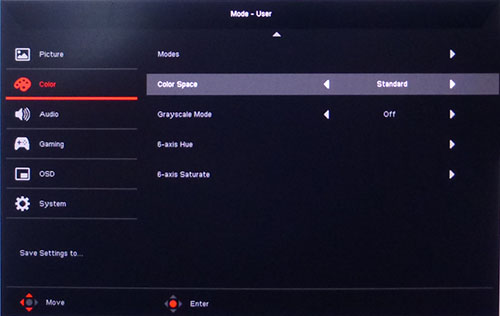
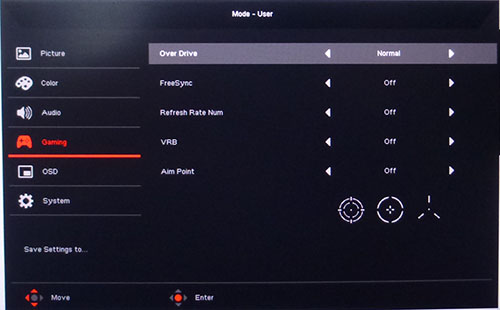
We've included a couple of screenshots from
the OSD menu above for reference. The menu software looks pretty smart and has a
really large range of options which is great news. There's loads of preset
modes, colour controls, gaming options etc to play with. Navigation was
intuitive thanks to the joystick but the main issue with the menu was that it
was quite painfully slow to respond. It was a bit of a laborious task to
navigate around to be honest, as the clicks and presses take around half a
second to respond each time. Hopefully once you've got the screen set up to how
you like, or have saved some modes in the 3 customisable preset modes, it won't
be an issue but it was a bit annoying to use.
There is a good range of ergonomic
adjustments offered by the stand. Tilt offers a very wide range and is smooth
and easy to
move. There is a 100mm height adjustment which
smooth and pretty easy to move. At the lowest setting the bottom edge of the screen is
60mm from the top of the desk, and 160mm when at maximum height extension. Side
to side swivel is provided and is smooth and easy to use too. Rotation to
portrait mode is not included from this stand, but not really missed. There is pretty
much no wobble at all from the screen when you re-position it, and the stand is
providing a very sturdy and stable base.
A summary of the ergonomic adjustments are
shown below:
|
Function |
Range |
Smoothness |
Ease of
Use |
|
Tilt |
Yes |
Smooth |
Easy |
|
Height |
120mm |
Smooth |
A bit stiff |
|
Swivel |
Yes |
Smooth |
Easy |
|
Rotate |
No |
- |
- |
|
Overall |
Good set of adjustments
and all smooth and pretty easy to move. Screen remains stable with no wobble. |
The back of the screen features the
connections. There are the power connection, 2x HDMI 2.0, 2x DisplayPort 1.4, USB upstream, 2x USB 3.0
downstream and 1x headphone jack connections provided. There are also an
additional 2x USB 3.0 ports located on the left hand edge of the screen for
easy access which is useful.
The 'ambient light' feature can be enabled
via the OSD menu as well and has various options. This lights up a row of
LED's along the bottom edge of the screen and has various different effects,
colours and brightness settings. It adds an additional premium feel for the
screen and might be attractive to some people.

Power Consumption
In terms of power consumption the
manufacturer lists a typical usage of 55W and 0.5W in sleep mode.
We carried out our normal tests to establish its power consumption ourselves in
a few states.
|
 |
|
State and Brightness Setting |
Manufacturer Spec (W) |
Measured Power Usage (W) |
|
Default (80%) |
55.0 |
50.4 |
|
Calibrated (3%) |
- |
28.3 |
|
Maximum Brightness
(100%) |
- |
55.8 |
|
Minimum Brightness
(0%) |
- |
26.5 |
|
Standby |
0.5 |
0.5 |
|
Out of the box the screen used 50.4W at the
default 80% brightness setting. Once calibrated the screen reached 28.3W
consumption, and in standby it used only 0.5W. We have plotted these results
below compared with other screens we have tested. The consumption (comparing the
calibrated states) is pretty similar to the other 27" models we've tested, and a
little less than the Asus ROG Swift PG27UQ (45.1W) which has the added FALD HDR
backlight.


Panel and Backlighting
|
Panel Manufacturer |
AU Optronics |
Colour Palette |
1.07 billion |
|
Panel Technology |
AHVA (IPS-type) |
Colour Depth |
8-bit + FRC |
|
Panel Module |
M270QAN02.3 |
Colour space |
Extended gamut |
|
Backlighting Type |
W-LED
with Quantum Dot Enhancement Film |
Colour space coverage (%) |
Up to 90% DCI-P3 quoted
(97.5% DCI-P3 measured) |
|
|
Key
Quick Information Box
-
4K @
144Hz IPS-type panel
-
10-bit
colour depth supported
-
Extended gamut with high DCI-P3 coverage
-
Flicker free backlight
|
|
Panel Part and Colour Depth
The Acer Nitro XV273K features an
AU Optronics M270QAN02.3 AHVA (IPS-type) technology panel which is capable of producing
1.07 billion colours. This is achieved through a 8-bit+FRC colour depth as
detailed in the manufacturers specification. Some people may complain that the
panel is not a native full 10-bit panel, but in reality you are going to be very
hard pressed to see any real difference in practice between a good 8-bit+FRC
panel and a true 10-bit panel. Even more so when you consider whether you're
going to actually be able to use the 10-bit colour depth in real use.
This screen is aimed at gaming of course, and
AMD gaming graphics card users. There is a bit of confusion online about whether
these consumer grade graphics cards can truly support 10-bit or not so we will
try and clear that up a bit here. AMD consumer grade gaming graphics cards users
can use 10-bit, but the important thing to note though is
that for Windows users this is for Direct X applications like games only, and
does not apply for professional applications like Adobe Premiere Pro or Adobe
Photoshop. So you can use an AMD consumer-grade graphics card for
10-bit colour depth in gaming, as long as it is a game which support that colour
depth.
However, while the AMD cards can
support 10-bit for DirectX, this is not supported for the aforementioned
professional applications like Photoshop. Those programs use OpenGL 10-bit
colour buffers which are not supported from the AMD consumer grade cards. You would
need an AMD FirePro professional grade card for 10-bit support in those
professional applications. Achieving 10-bit colour depth can be quite tricky, as
it requires an end to end 10-bit workflow including software/game > relevant
graphics card > supported drivers > supported operating system > supported
display interface > supported display. The good news is that the XV273K will
support 10-bit content and given this is firmly aimed at gamers, that will mean
most will use that support from their AMD consumer cards when it comes to HDR
gaming, but not be able to make use of it for any professional applications.
Just make sure you have all the relevant software and operating systems in place
if you want to use it.
The panel part is confirmed when dismantling
the screen as shown below:

Screen
Coating
The
screen coating is a light anti-glare (AG) offering. It isn't a semi-glossy
coating, but it is light as seen on other modern IPS type panels. Thankfully it
isn't a heavily grainy coating like some old IPS panels feature and is also
lighter than modern TN Film panel coating. It retains its anti-glare properties
to avoid too many unwanted reflections of a full glossy coating, but does not
produce too grainy or dirty an image that some thicker AG coatings can.
There are no visible cross hatching patterns on the panel coating.
Backlight Type and Colour Gamut
The screen uses an LED backlight unit with an
added Quantum Dot Enhancement Film (QDEF) coating to extended the colour space
and gamut. This allows for a high coverage of the DCI-P3 colour space which is
the reference used for HDR content and displays and something you will see more
commonly talked about with TV's and monitors in the future. This screen offers
"up to 90% coverage" of the DCI-P3 colour space according to the specs,
something that we will verify and test in a moment. This corresponds to around
125% of the commonly used sRGB reference.
Basically the screen is capable of producing
a wide range of colours than most monitors, which are normally based around
providing coverage of the common sRGB colour space. With the Quantum Dot coating
film, the XV273K can cover beyond that, producing more bright and vivid colours
to enhance gaming, multimedia and HDR content. If you want to read more about
colour spaces and gamut then please have a read of our
detailed article.
Backlight
Dimming and Flicker
We tested the screen to establish the methods
used to control backlight dimming. Our in depth article talks in more details
about a previously very common method used for this which is called
Pulse Width Modulation (PWM). This in itself gives cause for concern to some
users who have experienced eye strain, headaches and other symptoms as a result
of the flickering backlight caused by this technology. We use a photosensor +
oscilloscope system to measure backlight dimming control with a high level of
accuracy and ease. These tests allow us to establish
1) Whether PWM is being used to control the
backlight
2) The frequency and other characteristics at which this operates, if it is used
3) Whether a flicker may be introduced or potentially noticeable at certain
settings
If PWM is used for backlight dimming, the
higher the frequency, the less likely you are to see artefacts and flicker. The
duty cycle (the time for which the backlight is on) is also important and the
shorter the duty cycle, the more potential there is that you may see flicker.
The other factor which can influence flicker is the amplitude of the PWM,
measuring the difference in brightness output between the 'on' and 'off' states.
Please remember that not every user would notice a flicker from a backlight
using PWM, but it is something to be wary of. It is also a hard thing to
quantify as it is very subjective when talking about whether a user may or may
not experience the side effects.
100%
50%
0%
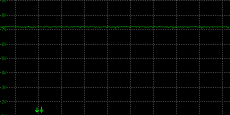
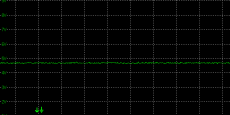
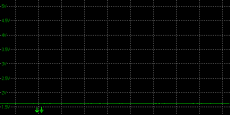
Above scale
= 1 horizontal grid = 5ms
At all brightness settings a constant
Direct Current (DC) voltage is applied to the backlight, and the screen is
free from the obvious off/on switching of any PWM dimming method. As a result,
the screen is flicker free as advertised.
|
Pulse
Width Modulation Used |
No |
|
Cycling
Frequency |
n/a |
|
Possible Flicker at |
|
|
100% Brightness |
No |
|
50% Brightness |
No |
|
0% Brightness |
No |

Brightness
and Contrast
We wanted to measure the luminance range
available from the backlight as well as see how much variance there
was in the screens contrast as we adjusted the monitor setting for brightness.
In theory, brightness and contrast are two independent parameters, and good
contrast is a requirement regardless of the brightness adjustment.
Unfortunately, such is not always the case in practice. We recorded the
screens luminance and black depth at various OSD brightness settings, and
calculated the contrast ratio from there. Graphics card settings were left at
default with no ICC profile or calibration active. Tests were made using an
X-rite i1 Display Pro colorimeter. It should be noted that we used the
BasICColor calibration software here to record these, and so luminance at
default settings may vary a little from the LaCie Blue Eye Pro report.
|
OSD
Brightness |
Luminance
(cd/m2) |
Black Point (cd/m2) |
Contrast Ratio
( x:1) |
|
100 |
503.14 |
0.47 |
1071 |
|
90 |
467.83 |
0.44 |
1063 |
|
80 |
432.62 |
0.41 |
1055 |
|
70 |
399.70 |
0.37 |
1080 |
|
60 |
362.43 |
0.34 |
1066 |
|
50 |
323.98 |
0.30 |
1080 |
|
40 |
277.26 |
0.26 |
1066 |
|
30 |
235.87 |
0.22 |
1072 |
|
20 |
196.17 |
0.18 |
1090 |
|
10 |
151.47 |
0.14 |
1082 |
|
0 |
104.58 |
0.10 |
1046 |
|
Total Luminance Adjustment Range
(cd/m2) |
398.56 |
Brightness OSD setting
controls backlight? |
 |
|
Total Black Point Adjustment Range (cd/m2) |
0.37 |
|
Average Static Contrast Ratio |
1070:1 |
PWM Free? |
 |
|
Recommended OSD setting for 120 cd/m2 |
3 |
At the top end the maximum luminance reached
a very high 503
cd/m2
which was extremely bright, and a lot higher also than the specified maximum
brightness of 400 cd/m2
from the manufacturer. The availability of a high brightness backlight will
be very useful when it comes to using the
strobing blur
reduction backlight (VRB mode) which we will look at later, or to offer improved peak brightness points
within HDR content - even if the screen is lacking any local dimming to actually
improve the dynamic range.
There was a wide 399 cd/m2 adjustment range in
total, so at the minimum setting you could reach down to a moderate luminance of
105 cd/m2. This should be low enough for a lot of people in normal
conditions, although
those wanting to work in darkened room conditions with low ambient light might
find it a little limited, as it can't reach as low as some screens. A setting of
3 in the OSD
menu should return you a luminance of around 120 cd/m2 at default
settings.
It should be noted
that the brightness regulation is controlled without the need for
Pulse Width Modulation for all brightness settings so the screen is flicker
free.

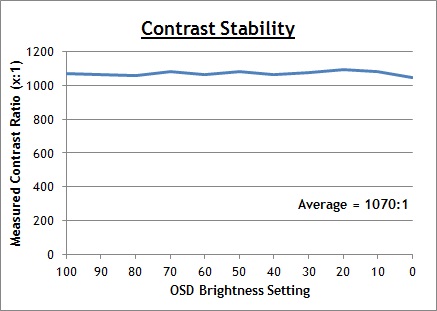
We have plotted the
luminance trend on the graph above. The screen behaves as it should in this
regard, with a reduction in the luminance output of the screen controlled by the
reduction in the OSD brightness setting. This is basically a linear relationship
as you can see although the adjustment curve seems to be slightly steeper
between 50 and 0% brightness levels.
The average contrast ratio of the screen
was measured at 1070:1 which was good for an IPS-type panel. This remains stable
across the brightness adjustment range.

Testing
Methodology
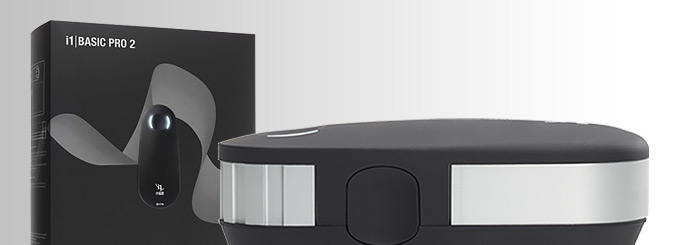
An important thing to consider for most users
is how a screen will perform out of the box and with some basic manual
adjustments. Since most users won't have access to hardware colorimeter tools,
it is important to understand how the screen is going to perform in terms of
colour accuracy for the average user.
We restored our graphics card to default
settings and disabled any previously active ICC profiles and gamma corrections.
The screen was tested at default factory settings using our new
X-rite i1 Pro 2
Spectrophotometer combined with
LaCie's Blue Eye Pro software suite. An X-rite i1 Display Pro colorimeter
was also used to verify the black point and contrast ratio since the i1 Pro 2
spectrophotometer is less reliable at the darker end.
Targets for these tests are as follows:
-
CIE Diagram - validates the colour
space covered by the monitors backlighting in a 2D view, with the black triangle
representing the displays gamut, and other reference colour spaces shown for
comparison
-
Gamma - we aim for 2.2 which is the
default for computer monitors
-
Colour temperature / white point - we
aim for 6500k which is the temperature of daylight
-
Luminance - we aim for 120
cd/m2,
which is the recommended luminance for LCD monitors in normal lighting
conditions
-
Black depth - we
aim for as low as possible to maximise shadow detail and to offer us the best
contrast ratio
-
Contrast ratio -
we aim for as high as possible. Any dynamic contrast ratio controls are turned
off here if present
-
dE average / maximum
- as low as possible.
If DeltaE >3, the color displayed is significantly different from the
theoretical one, meaning that the difference will be perceptible to the viewer.
If DeltaE <2, LaCie considers the calibration a success; there remains a slight
difference, but it is barely undetectable. If DeltaE < 1, the color fidelity is
excellent.

Default Setup
Default settings of the screen were as follows:
Acer
Nitro XV273K
Default Settings
 

|

 |
|
Monitor
OSD Default Settings |
|
|
Preset Mode |
Standard |
|
Color Space |
Standard |
|
Brightness |
80 |
|
Contrast |
50 |
|
Color Temp |
Warm |
|
Gamma |
2.2 |
|
RGB |
50, 50, 50 (locked) |
|
Luminance
Measurements |
|
|
luminance (cd/m2) |
440 |
|
Black Point (cd/m2) |
0.41 |
|
Contrast Ratio |
1061:1 |
|
Colour
Space Measurements |
|
|
sRGB coverage |
132.3% |
|
DCI-P3 coverage |
97.5% |
|
Rec.2020 coverage |
70.0% |
|
|
Initially out of the box the screen was set
with the standard preset mode which offered the full native gamut of the
backlight. Colours appeared more vivid and saturated compared with a normal sRGB
screen, making them appear more bright and colourful. There is an sRGB emulation
mode preset as well which we will test in a moment, and that also carries the
screen's factory calibration.
We went ahead and measured the default state
with the i1 Pro 2. The
CIE diagram
on the left of the image confirms that the monitors colour gamut (black
triangle) extends beyond the sRGB colour space reference
(orange triangle) quite considerably in all shades. We measured using ChromaPure software a
132.3% sRGB gamut
coverage which corresponds to 97.5% of the DCI-P3 reference and 70.0% of the
Rec.2020 reference. This was actually a fair bit beyond Acer's spec of 90%
DCI-P3 coverage. There are a range of other colour space modes available in the
menu including sRGB, HDR (the same full native gamut), and DCI-P3 which actually
offers around 90.8% DCi-P3 coverage and perhaps is where their spec has come
from.
Default gamma of the screen was recorded at
2.2 average, with a very small 1% deviance from the target which was great news,
and showed a similar deviance across all grey shades.
|
|
Key
Quick Information Box
-
Default setup pretty good with a reliable gamma
-
Colour
temp a
little too warm
-
Default contrast ratio good at 1061:1
-
97.5%
DCI-P3 coverage measured, beyond spec even
-
sRGB
emulation mode available with very good factory calibration
|
|
White point was measured
at a slightly too warm 6107k being a small 6% out from our 6500k target.
Luminance was recorded at a very bright 440
cd/m2
which is far too high for prolonged general use, you will need to turn that
down. The screen was set at a default 80% brightness in the OSD menu but that is
easy to change of course to reach a more comfortable setting without impacting
any other aspect of the setup. The black depth was 0.41 cd/m2
at this default brightness setting, giving us a good static contrast ratio for
an IPS-type panel of 1061:1. We have seen some IPS panels reach up to around 1200
- 1400:1 recently but somewhere around 1000:1 is still decent for this technology.
Colour accuracy measurements show a dE
average of 2.4 but keep in mind that the screens wider gamut output is being
compared here with an sRGB
reference so will be skewed as a result. Testing the screen with colour
gradients showed smooth transitions with only minor gradation evident in the
darker tones. There was no sign of any colour banding which was good news.

Factory Calibration
The XV273K carries a factory calibration which is applicable in the 'sRGB colour
space' mode and is calibrated to achieve accurate grey-scale tracking and a delta E of <1. The screen comes with a specific factory
calibration report for the unit as shown by the example which came with ours:
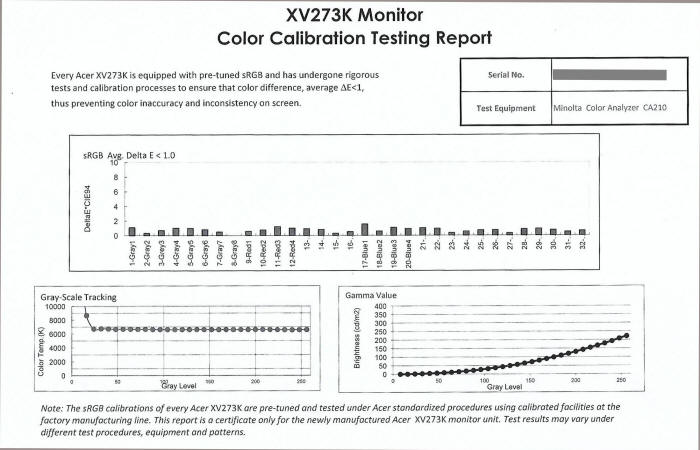
Above: factory calibration report. Click for larger version

You have to switch to this mode in the
'colour space' setting in the OSD menu, changing it to sRGB where the smaller
colour space is emulated, and where the factory calibration has been applied.
Default settings of the screen in the sRGB mode were as follows:
Acer
Nitro XV273K
sRGB Colour Space
(Factory Calibration)
 

|
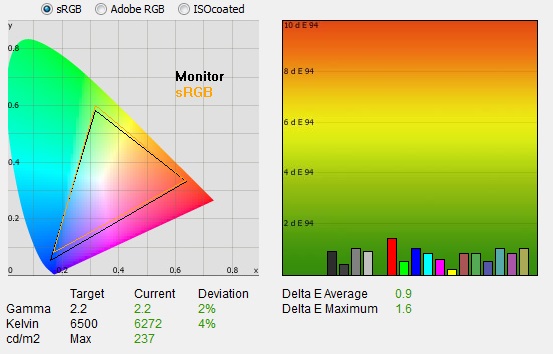
 |
|
Monitor
OSD Default Settings |
|
|
Preset Mode |
Standard |
|
Color Space |
sRGB |
|
Brightness |
30 |
|
Contrast |
n/a |
|
Color Temp |
n/a |
|
Gamma |
n/a |
|
RGB |
n/a |
|
Luminance
Measurements |
|
|
luminance (cd/m2) |
237 |
|
Black Point (cd/m2) |
0.22 |
|
Contrast Ratio |
1083:1 |
|
Colour
Space Measurements |
|
|
sRGB coverage |
96.4% |
|
DCI-P3 coverage |
71.1% |
|
Rec.2020 coverage |
51.0% |
|
When you switch to the sRGB mode a lot of the
settings in the OSD are unavailable or disappear. This includes settings for
contrast, low blue light modes, colour temperature and gamma. You can still
alter the brightness control thankfully, which is sometimes locked on displays
with an sRGB mode, and normally makes them practically useless. Thankfully you
can customise the brightness here on the XV273K. The screen also has the 'Super
Sharpness' setting turned on in this sRGB mode which accentuates the sharpness
of the screen. You can turn that off if you don't like it.
You can see from the CIE diagram on the left
that the colour space now more closely matches the sRGB reference space as
intended. We measured using ChromaPure software a 96.4% sRGB gamut
coverage which corresponds to 71.1% of the DCI-P3 reference and 51.0% of the
Rec.2020 reference and represented a good emulation of this smaller colour
space.
Default gamma of the screen was recorded at 2.2
average, with a small 2% deviance from the target which was great news. White point was measured
at a slightly too warm 6272k being only a small 4% out from our 6500k target now.
Luminance was recorded at a still-too-bright 237
cd/m2
which is too high for prolonged general use, you will need to turn that down
still even from the 30% setting.
The black depth was 0.22 cd/m2
at this brightness setting, maintaining a good static contrast ratio for
an IPS-type panel of 1083:1. Colour accuracy was excellent with an average dE of
0.9, which was in line than the target of <1 from the factory calibration. Again
there was smooth gradients with no banding evident in this mode. Overall it
represented a very good factory calibration which was pleasing.

Calibration
We used the
X-rite i1 Pro 2
Spectrophotometer combined with the LaCie Blue Eye Pro software package to
achieve these results and reports. An X-rite i1 Display Pro colorimeter was used
to validate the black depth and contrast ratios due to lower end limitations of
the i1 Pro device.
Acer
Nitro XV273K
Calibrated Settings
 

|
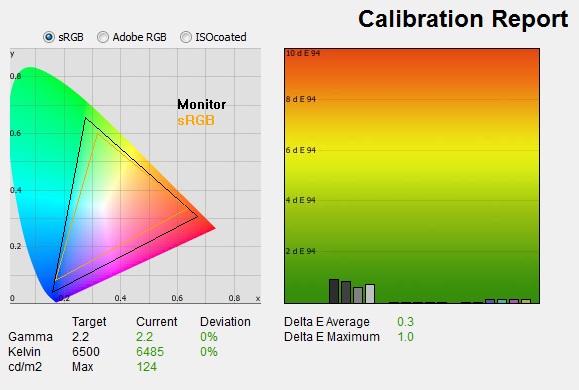
 |
|
Monitor
OSD Default Settings |
|
|
Preset Mode |
Standard |
|
Color Space |
Standard |
|
Brightness |
3 |
|
Contrast |
50 |
|
Color Temp |
User |
|
Gamma |
2.2 |
|
RGB |
44, 50, 48 |
|
Luminance
Measurements |
|
|
luminance (cd/m2) |
124 |
|
Black Point (cd/m2) |
0.12 |
|
Contrast Ratio |
1019:1 |
|
Colour
Space Measurements |
|
|
sRGB coverage |
132.3% |
|
DCI-P3 coverage |
97.5% |
|
Rec.2020 coverage |
70.0% |
|
We changed here to the user mode in the
colour temp menu
which gives you access to the RGB channel adjustments. We stuck with the default
2.2 gamma mode which we knew to be very close to the target out of the box. Settings were
adjusted as shown in the table above, as guided during the calibration process
and measurements.
These OSD changes allowed us to obtain an optimal hardware starting point and
setup before software level changes would be made at the graphics card level. We
left the LaCie software to calibrate to "max" brightness which would just
retain the luminance of whatever brightness we'd set the screen to, and would
not in any way try and alter the luminance at the graphics card level, which can
reduce contrast ratio. These adjustments before profiling the screen would help
preserve tonal values and limit banding issues. After this we let the software
carry out the LUT adjustments and create an
ICC profile.
Average gamma was measured at 2.2 average
after calibration (0%
deviance) which fixed the very small 1% deviance we'd seen out of the box at default
settings. The white point had also now been corrected to 6485k, sorting out the
6% deviance we had by default. Luminance had been improved thanks to the
adjustment to the brightness control and was now being measured at a far more
comfortable 124
cd/m2.
This left us a black depth of 0.12 cd/m2 and a static contrast ratio
of 1019:1 which was good for IPS panel technology. Colour accuracy of the resulting profile was excellent too, with dE
average of 0.3 and maximum of 1.0. LaCie would consider colour fidelity to be
excellent.
Testing the screen with various colour
gradients showed very smooth transitions with only some very minor gradation in darker
tones and some very slight banding in places.
You can use our settings
and try our calibrated ICC profile if you wish, which are available in
our ICC profile database. Keep in mind that results will vary from one
screen to another and from one computer / graphics card to another.

Calibration
Performance Comparisons
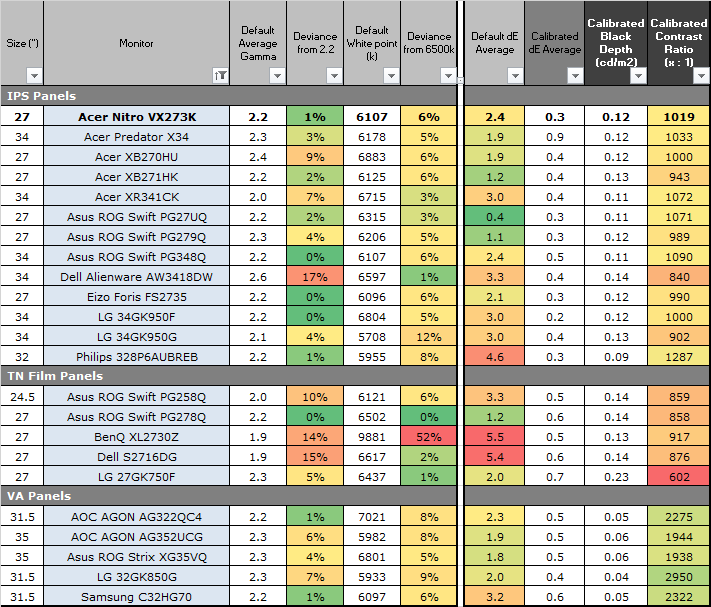
The comparisons made in this section try to
give you a better view of how each screen performs, particularly out of the box
which is what is going to matter to most consumers. We have divided the table up
by panel technology as well to make it easier to compare similar models. When
comparing the default factory settings for each monitor it is important to take
into account several measurement areas - gamma, white point and colour accuracy.
There's no point having a low dE colour accuracy figure if the gamma curve is
way off for instance. A good factory calibration requires all 3 to be well set
up. We have deliberately not included luminance in this comparison since this is
normally far too high by default on every screen. However, that is very easily
controlled through the brightness setting (on most screens) and should not
impact the other areas being measured anyway. It is easy enough to obtain a
suitable luminance for your working conditions and individual preferences, but a
reliable factory setup in gamma, white point and colour accuracy is important
and some (gamma especially) are not as easy to change accurately without a
calibration tool.
From these comparisons we can also compare
the calibrated colour accuracy, black depth and contrast ratio. After a
calibration the gamma, white point and luminance should all be at their desired
targets.
The XV273K comes out of the box set at its
native full DCI-P3 colour space, offering more vivid and brighter colours for
gaming and multimedia. It has a decent setup in terms of gamma and has a good
IPS contrast ratio as well. The white point is a little too warm out of the box,
but easy enough to correct through the OSD controls. The screen also carries an excellent factory
calibration in the SRGB emulation mode that we were really impressed with, especially considering this is
primarily a gaming screen and those are often set up for less "accurate"
targets. In that factory calibrated mode we had a reliable sRGB gamut emulation,
a good gamma curve, white point with only a couple of %
deviance from the targets, and an excellent dE of only 0.9. No
complaints about the default setup here and plenty of settings available in the
menu too.
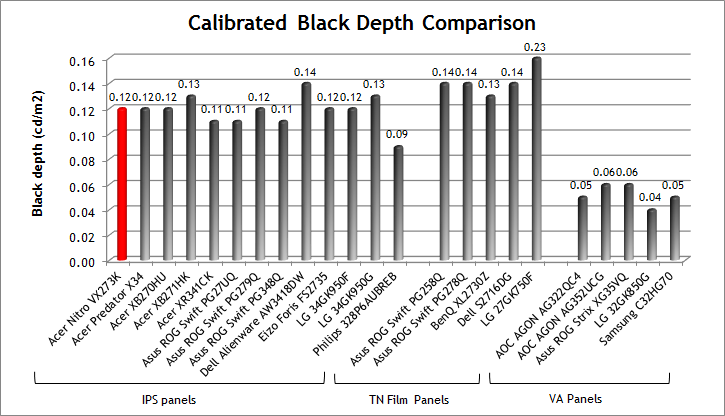
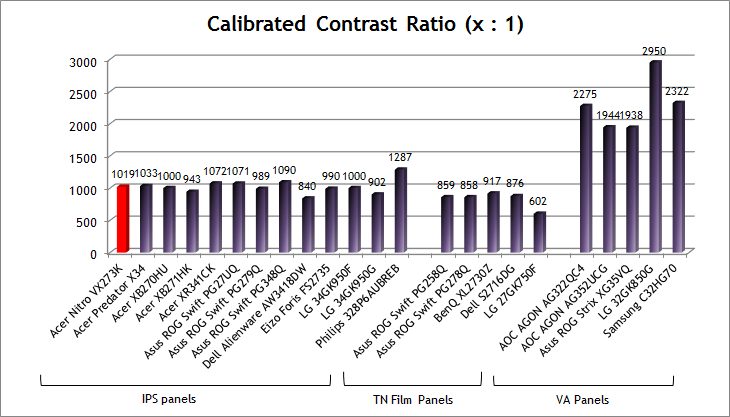
When it comes to black depth and contrast
ratio the screen performed well for an IPS-type panel, with a calibrated
contrast ratio of 10191:1. We have seen some modern IPS panels start to reach up
to 1200 - 1400:1 or so as you can see above, but somewhere around 1000:1 is
still respectable for this technology, with some others dipping under that down
to the 800 - 900:1 range. You can see that IPS cannot compete with VA technology
panels though which typically reach up to 2000:1 or more although they do tend
to be slightly better than TN Film panels.
|
Check Pricing and Buy -
Affiliate Links
|
|
Amazon
|
|
TFTCentral is a participant
in the Amazon Services LLC Associates Programme, an affiliate
advertising programme designed to provide a means for sites to earn
advertising fees by advertising and linking to Amazon.com, Amazon.co.uk,
Amazon.de, Amazon.ca and other Amazon stores worldwide. We also
participate in a similar scheme for Overclockers.co.uk. |

Viewing Angles
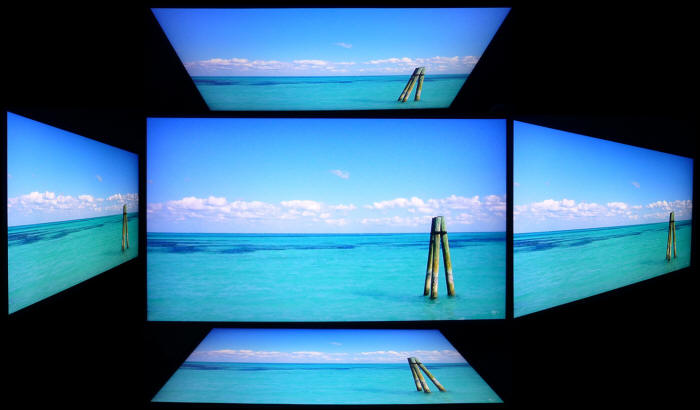
Above: Viewing angles shown from front and side, and from above and below.
Click for larger image
Viewing angles of the screen were very good
as you would expect from an IPS-type panel. Horizontally there was very little
colour tone shift until wide angles past about 45°. A slight darkening of the
image occurred horizontally from wider angles as you can see above as the
contrast shifted slighting. Contrast shifts were slightly more noticeable in the
vertical field but overall they were very good. The screen offered the wide
viewing angles of IPS technology and was free from the restrictive fields of
view of TN Film panels, especially in the vertical plane. It was also free of
the off-centre contrast shift you see from VA panels and a lot of the quite
obvious gamma and colour tone shift you see from some of the modern VA panel
type offerings.
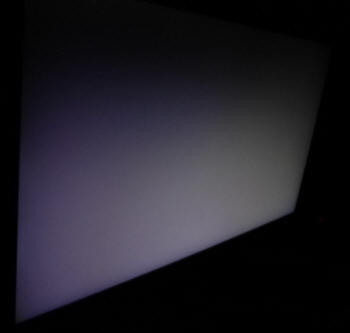
Above: View
of an all black screen in a dark room from the side. Click for larger version
On a black image there is a characteristic
pale glow introduced to the image when viewed from a wide angle, commonly
referred to as IPS glow. This type of glow is common on most modern IPS-type
panels and can be distracting to some users. If you view dark content from a
normal head-on viewing position, you may see this glow as your eyes look towards
the edges of the screen. The level of glow was fairly typical for an IPS-type
panel, although we had been impressed by the
Asus ROG Swift PG27UQ's low glow panel in this area. It looks like the
slightly different panel revision here, despite being 4K @ 144Hz, returns to a
more standard IPS-glow level than on those top-end FALD HDR models.

Panel Uniformity
We wanted to
test here how uniform the brightness was across the screen, as well as identify
any leakage from the backlight in dark lighting conditions. Measurements of the
luminance were taken at 35 points across the panel on a pure white background.
The measurements for luminance were taken using BasICColor's calibration
software package, combined with an X-rite i1 Display Pro colorimeter with a
central point on the screen calibrated to 120 cd/m2. The below
uniformity diagram shows the difference, as a percentage, between the
measurement recorded at each point on the screen, as compared with the central
reference point.
It is worth
noting that panel uniformity can vary from one screen to another, and can depend
on manufacturing lines, screen transport and other local factors. This is only a
guide of the uniformity of the sample screen we have for review.

Uniformity of Luminance
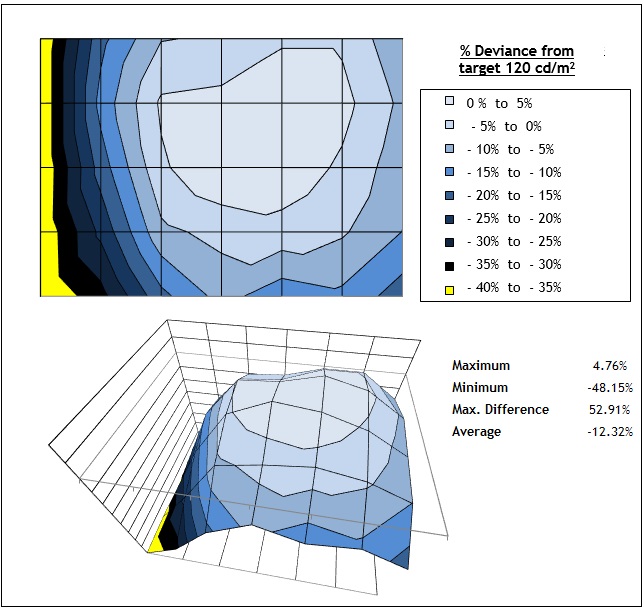
The
uniformity of our XV273K sample was not very good unfortunately, although
this will of course vary from sample to sample. The main problem was that
the left third of the screen was much darker than the central and right hand
areas. This wasn't really noticeable in normal usage at all we should point
out, but if you were wanting to do any colour critical work, or photo
editing for instance you might spot some variation in the luminance of the
screen which could cause problems. The left hand side of the screen dropped
down to a low of 81 cd/m2 which was -48% deviance from the
centrally calibrated area. The uniformity was better in the central and
right hand areas thankfully with an average deviance of around 2%, although
there was a slightly larger variation along the bottom edge as well with a
13% average deviance. Overall, 60% of the screen was within a 10% variance
from the centrally calibrated point.

Backlight Leakage
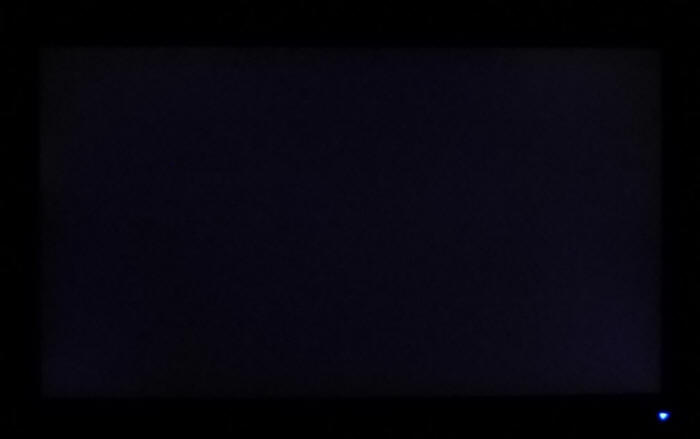
Above: All
black screen in a darkened room. Click for larger version
We also tested the screen with an all black
image and in a darkened room with a camera used to capture the result. The
camera showed there was no noticeable backlight bleed or clouding on this sample
and uniformity was very good. The right hand corners were slightly brighter than
the rest of the screen but you couldn't see this in normal use at all.
Note: if you want to test your own screen for
backlight bleed and uniformity problems at any point you need to ensure you have
suitable testing conditions. Set the monitor to a sensible day to day brightness
level, preferably as close to 120
cd/m2 as you can get it (our tests
are once the screen is calibrated to this luminance). Don't just take a photo at
the default brightness which is almost always far too high and not a realistic
usage condition. You need to take the photo from about 1.5 - 2m back to avoid
capturing viewing angle characteristics, especially on IPS-type panels where
off-angle glow can come in to play easily. Photos should be taken in a darkened
room at a shutter speed which captures what you see reliably and doesn't
over-expose the image. A shutter speed of 1/8 second will probably be suitable
for this.

General and Office Applications
The XV273K feature a 3840 x 2160 Ultra HD
resolution, all packed in to a 27" sized screen. The higher resolution is not
about providing more screen real-estate here and we need to move away from
thinking about LCD resolution in that manner. In fact it is arguable that the
wide range of 2560 x 1440 resolution panels in the 27" sector are about as high
a resolution as you want to go, without making fonts and icons too small
natively. That provides a pretty comfortable option to work with day to day.
Here, with the resolution being so much
higher it is about providing a sharper and crisper image, while still operating
with a similar desktop area and similar font size to the 1440p models. It is
providing a higher pixel density (Pixels Per Inch, PPI) to improve the degree of
definition to the image. You need to us operating system scaling to handle this
properly. If you try and run the screen without any scaling at 3840 x 2160 the
0.156mm pixel pitch makes everything far too small and tiny. In our view you
need a screen of about 39 - 40" in size (like the
Philips BDM4065UC for example) to use an Ultra HD or 4K resolution
effectively without OS scaling. On this 27" model, if you increase the scaling
to 150%, you actually end up with the same workspace area as 2560 x 1440, but at
a much higher PPI pixel density - and therefore a sharper image. Have a read of
Eizo's very useful article for some more information on the whole matter.
For those wanting a high pixel density for CAD, design, photo work etc, this is
a really good option. The image was very sharp and crisp and text was very
clear. It is a little debatable whether you will gain much benefit from the
higher PPI on a screen this size compared with a 2560 x 1440 standard model, but
some may notice picture quality and sharpness improvements.
Keep in mind that not all Operating Systems
and applications handle scaling the same. More recent versions of Windows (8.1
and 10) tend to handle it all better, and recent versions of Mac OS are pretty
solid as well. Some applications and games don't handle scaling correctly and so
you can end up with some things with very minute text and fonts and some things
which don't scale completely in every place. Keep this in mind if you're
selecting any super high resolution display as it could be an important factor.
You need to ensure you have the necessary operating system and applications to
handle scaling effectively for your needs.
The light AG coating of the panel is welcome,
and much better than the grainy and dirty appearance of older IPS AG coatings.
The wide
viewing angles provided by this panel technology on both horizontal and vertical
planes, helps minimize on-screen colour shift when viewed from different angles.
The default setup of the screen was very good
as well, offering an accurate gamma curve, white point and decent contrast ratio for an IPS panel.
There is support for both the native DCI-P3 colour space (default mode) and an
emulated sRGB colour space if you need it. There is a very low dE for great
colour accuracy in the sRGB mode thanks
to the very good factory calibration. Those wanting to work with wide gamut
content for multimedia and HDR can achieve good coverage of the DCI-P3 colour space as well.
The
brightness range of the screen was wide, although a little limited at the lower
adjustment range. There is the ability to offer a luminance between 503 and 104 cd/m2. This
may not be quite dark enough for some people who want to use the screen in lower
ambient light conditions, including darkened rooms. A setting of 3 in the OSD brightness control should return
you a luminance close to 120 cd/m2 out of the box. The brightness regulation is controlled without the need for the
use of
Pulse-Width Modulation (PWM), and so those who suffer from eye fatigue or
headaches associated with flickering backlights need not worry. A range of blue
light filter modes are provided to help reduce blue spectral output and make the
screen easier on the eyes, especially for lots of text work or in darker room
conditions.
The screen offers 4x USB 3.0 ports which is
very handy, with 2x located on the back of the screen with the video
connections, but 2x provided on the left hand edge which are easy access. There is also a headphone jack if you
are sending sound to the screen along with 2x 4W integrated
speakers which are probably ok for the occasional YouTube video or mp3. There is a built in ambient light sensor which is located
on the top edge of the screen and has 3 levels in the OSD settings which will
adjust your screen's brightness depending on your working conditions and other
light sources. There aren't
any other extras like card readers provided here which are sometimes useful on
office environments. The stand offers a wide range of adjustments which is great
news, allowing you to obtain comfortable viewing positions easily.

Responsiveness and Gaming
Introduction
and Testing Methodology
|
Panel Manufacturer and
Technology |
AU Optronics AHVA
(IPS-type) |
|
Panel Part |
M270QAN02.3 |
|
Quoted G2G Response Time |
4ms G2G |
|
Quoted ISO Response Time |
n/a |
|
Overdrive Used |
Yes |
|
Overdrive Control
Available Via OSD Setting |
Overdrive |
|
Overdrive OSD Settings |
Off, Normal, Extreme |
|
Maximum
Refresh Rate |
60Hz (HDMI)
120Hz (native single DP connection)
144Hz (with dual DP mode) |
|
Variable
Refresh Rate technology |
AMD FreeSync |
|
Variable
Refresh Rate Range
|
48 - 120/144Hz |
|
Blur
Reduction Backlight |
Yes - 'VRB' mode |
The XV273K is rated by Acer as having a
4ms G2G response time. The screen uses
overdrive / response time compensation (RTC) technology to boost pixel
transitions across grey to grey changes as with nearly all modern displays. They
also promote a "1ms MPRT" spec which is related to the strobing blur reduction
backlight available using the VRB mode.

There is a user control in the OSD menu for the overdrive under the 'Overdrive' setting with 3 options available -
Off, Normal and Extreme. The part
being used is
AU Optronics M270QAN02.3 AHVA (IPS-type) technology panel. Have a read
about response time in our
specs section if you need additional information about this measurement.
We use an
ETC M526
oscilloscope for these measurements along with a custom photosensor device.
Have a read of
our response time measurement article for a full explanation of the testing
methodology and reported data.
Graphics Card and System Considerations
|
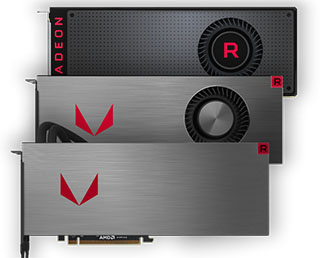 |
|
Purchasing Recommendations - Help Support Us
You can
help to support TFTCentral by purchasing your display and other hardware
via our affiliate links below. This helps us earn a small referral fee for
any purchase you make and contributes towards the ongoing running of this
site. Thank you. |
|
AMD Radeon RX Vega 64 range:
Amazon
UK |
Amazon USA |
|
You
will need to keep in mind that these new range of 4K 144Hz displays like the
XV273K are very top-end displays, and to power
them you are going to need a powerful system for sure. Achieving 3840 x 2160
resolution at up to 144Hz refresh rate at high settings is
going to be a challenge for even the best systems, so to really make use of this
display you are going to also need to invest in other expensive, powerful
hardware. It is important that your graphics card has a DisplayPort
1.4 interface(s) as you are going to need that to achieve 4K at these high refresh
rates. For this particular screen it will need dual DisplayPort outputs if you
want to run at the maximum 144Hz refresh rate at 4K. We will talk about that a
bit more shortly. Acer provide two DP cables in the box so you don't need to worry about that
thankfully.
You can use the screen with either AMD or
NVIDIA graphics cards, but you are going to need a very top of the range card to
reach the screen's potential for resolution and refresh rate. AMD cards will be
able to support AMD FreeSync as well of course for variable refresh rates, but
may be more limited in their power compared to the top end NVIDIA cards. Of
course things will improve in the future as well to allow more people to make
the most of these kind of resolutions and refresh rates.
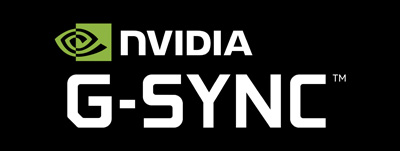
Update 8/2/19: The XV273K was one of
the first batch of 12 screens certified by NVIDIA as "G-sync Compatible",
meaning that through a driver update in January 2019 compatible graphics cards
will be able to use G-sync variable refresh rates (VRR) from this display,
even though it's not a traditional G-sync screen. So if you're an NVIDIA user,
you will be able to enjoy the VRR support as well, and give you more
flexibility for higher end graphics card choices. We didn't have chance to
test G-sync performance on this screen when we had it with us (before the
announcement and update from NVIDIA) but given it is a proper certified
"G-sync Compatible" display it means it has passed NVIDIA's quality and
performance tests and should work fine. Third party reports of the screen
since also confirm it works well.
Is 4K too high a resolution for a 27" screen
like this? That's another common question we see asked, and a lot of people
would prefer it if the screen was a little bigger in size.
AU
Optronics who produce the panel used here are also now planning a 32"
equivalent. Panel production was originally expected around Q3 2018 but
our most
recent information suggests this has slipped back to Q1 2019, presumably because
of the delays and challenges with the 27" versions. It will not be until
probably middle of 2019 at best before any monitors featuring those panels we
expect right now. Given how many times the 27" panel slipped, we wouldn't be
surprised to see the same with the larger 32" version.
At 27" in size, the Ultra HD resolution can't
really be used for desktop / general use without scaling in place, as the fonts
and text are just too small. For gaming and multimedia you do get an improvement
in the image sharpness and clarity thanks to the smaller pixel pitch and higher
PPI. Depending on your viewing distance, eye sight and game settings you may or
may not notice the difference in running at 4K resolution on a 27" screen
compared with a more common 1440p display. However, there are plenty of people
out there who do notice the difference and have invested in 4K resolution
screens of various sizes, many in this kind of range, and love that extra level
of detail and clarity they get.

Response Times at 60Hz (Consoles)



We carried out some initial response time
measurements in each of the overdrive settings, along with some visual tests in
order to identify what the optimal setting was. These tests were initially
carried out at 60Hz which is going to be your limit on this screen if you're
connecting a games console over HDMI at 3840 x 2160 Ultra HD resolution.
With the Overdrive setting 'off' the average G2G
response times were fairly slow at 12.2ms G2G which is quite typical for an
IPS-type panel. Switching up to 'normal' mode brought about some noticeable
improvements to motion clarity and reductions in the measured response times,
and perceived blurring on moving images. Average G2G was now measured at 8.1ms,
although some low to moderate levels of overshoot started to creep in on some
measurements. This was not very noticeable in practice or motion tests though
thankfully. Pushing up to the
'extreme' setting helped reduce the response times a little more, down to 6.1ms
G2G now. However a very large amount of overshoot was introduced, which was very
noticeable in practice. There were lots of pale halos behind moving objects and
it was not really useable. Response times were more than adequate to keep up
with the 60fps frame rate at 60Hz, and we would recommend opting for the
'Normal' overdrive mode if you're gaming from a console or running at 60Hz.

High Refresh Rates and 120Hz
120Hz Refresh Rate


When connected to a PC using the DisplayPort
1.4 interface you have access to the high refresh rate of the panel. The maximum
native refresh rate supported when you first connect the screen is 120Hz, which we will remind you is a big step
up for panels of this 4K resolution. We will explain how you reach the maximum
144Hz refresh rate in a moment.
The overdrive and response time behaviour of the screen
does vary depending on the active refresh rate. We didn't bother testing the 'off' mode here.
The 'normal' mode showed a change in the response time behaviour compared with
running the screen at 60Hz. The response times actually increased a little bit
here, from 8.1ms G2G at 60Hz, to 9.1ms G2G here at 120Hz. This seems a little
odd, as you would want the pixel transitions to improve in speed as the refresh
rate increased, in order to keep up with the higher frame rate demands. At 60Hz
you need response times to be consistently under 16.6ms to avoid additional
motion blur caused by the frame rate, but at 120Hz they need to really be under
8.3ms to keep up. Here on the XV273K in the 'normal' overdrive mode they were
not quite keeping up with the frame rates at 120Hz. Some of the transitions,
particularly those from black to lighter shades were a little too slow and it
introduced a bit of dark smearing on moving content. It was not a major issue to
be fair, and quite slight but we would have liked the response times to be a bit
faster really if possible. The good news about this 'normal' overdrive mode at
120Hz is that because the response times are not quite as fast as they were at
60Hz, it has at least
removed all signs of overshoot that we had before. It had been at low/moderate
levels at 60Hz but was gone by the time you reached these higher refresh rates.
Pushing the OD setting up to the maximum
'extreme' setting improved the response times quite a lot, but unfortunately
introduced a moderate amount of overshoot on a few transitions. In visual tests
there was some very slight pale trails behind moving objects but to be honest
they were minimal and probably unlikely to cause any real problems in gaming.
With the response times now consistently under 8.3ms, they were more than fast
enough to keep up with the 120Hz frame rate. In motion tests the image looked
sharper and clearer, with less of the smearing you can detect in the 'normal'
mode.
One other thing of note was that the screen
was perfectly happy allowing a lower resolution at a high refresh rate like
120Hz. You could switch down to 2560 x 1440 at 120Hz or 144Hz for instance without issue,
if you want to reduce your resolution for any reason, or to create less of a
drain on your system.

Chroma Sub-sampling
(n/a for maximum 144Hz)
To achieve a "4K" (3840 x 2160, strictly
Ultra HD) resolution and high refresh rates the bandwidth capabilities of the
latest DisplayPort 1.4 interface are already being pushed to their limit. The
interface is just not capable of supporting the really high end of the refresh
rate without some sacrifices, and so to achieve the higher end refresh rates
(except 144Hz which we will cover in a moment) you
will have to lower the colour support in one of a couple of ways. This might
sound like a big sacrifice, but don't be too alarmed. We will try and explain.
By default the refresh rate options available
on the XV273K in the graphics card control panel are 30, 60 and 120Hz. At 60Hz
it is within the bandwidth capabilities of DP 1.4 without any colour compression
being needed, and therefore you can run the screen just like you would any other
display. It will support the full 3840 x 2160 resolution with 10-bit colour depth support as well if you have a
game that can make use of it.
As we explained
earlier, 10-bit colour depth support is only applicable for gaming on this
display given the limitations of AMD consumer gaming graphics cards, and not for
professional applications like Photoshop. This is useful for HDR gaming
where 10-bit colour depth is more commonly used and a lot of other games may not
even support 10-bit anyway. No colour compression is needed for 60Hz anyway so 10-bit is there if you need it.
If you want to push the screen up to high
refresh rate of 120Hz then some kind of colour compression is required so that it can
fit within the bandwidth capabilities of DP 1.4. There are two ways this can be
achieved:
1) Drop from 10-bit colour depth to
8-bit - this might not actually make any real difference for many games,
especially if they are non-HDR games or just simply don't support 10-bit
colour depth. In a game where 10-bit is supported, or in HDR gaming you may
see some improvements in colour gradients when using 10-bit over 8-bit but
then again in some cases you may not see much real difference. For 120Hz
refresh rates you can drop the colour depth to 8-bit and then not worry about
the chroma sub-sampling discussed below.
2) Use Chroma Sub-sampling - this is a method for compressing the colour
information in a signal to save on bandwidth, without significantly impacting
the picture quality in many cases. This avoids the need to reduce the
luminance information (luma) in the signal which would have a more noticeable
impact on picture quality, and this method can help reduce the file size by a significant
amount. You can stay at 10-bit colour depth but sacrifice the chroma if you
want.
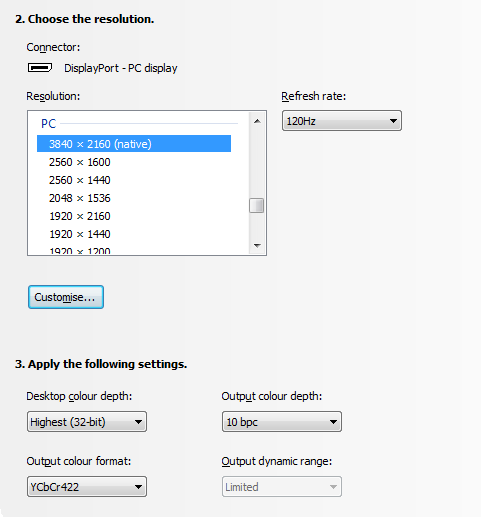
Chroma sub-sampling is represented by the
YCbCr setting in the 'output colour format' section in the graphics card
control panel we
showed earlier (copied above again for ease of reference). It is listed in a
format like 4:4:4, 4:2:2 or in some cases even 4:2:0. We will focus on 4:4:4
and 4:2:2 here as that's what is relevant to this display.
4:4:4 format is just the normal standard, uncompressed colour output where
sub-sampling is NOT needed and means that for a sample of 4 (the first digit),
there are 4 horizontal samples (second digital) and 4 vertical samples (third
digit). That's the norm and usually in the graphics card settings you would
see this listed as YCbCr444, or if it's just selected on 'RGB' then that
implies no chroma sub-sampling is needed either.
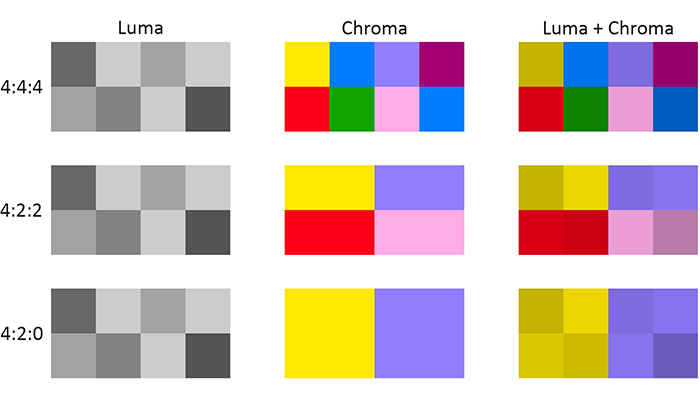
Image courtesy of
Rtings.com
4:2:2 is the colour compression option we
are interested in here for the XB273K. The two chroma components are sampled
at half the sample rate of luma. The horizontal chroma resolution is halved.
This reduces the bandwidth of an uncompressed video signal by one-third. On
this display if you want to run at 120Hz and maintain the 10-bit colour
depth output, then you will need to use this 4:2:2 chroma sub-sampling setting
in the graphics card control panel to allow support.
At 120Hz you can keep a full 4:4:4 chroma (no sub-sampling) and instead drop
to 8-bit colour depth and that will also work fine. A lot of games and SDR
content aren't even going to support 10-bit anyway. We will talk about the
144Hz refresh rate in a moment as that operates in a different way on the
XV273K.
Does Chroma sub-sampling make a
difference?
You will see that when you switch to YCbCr422
mode (4:2:2 chroma sub-sampling) that the 'output dynamic range' setting in the
NVIDIA control panel also switches to 'limited'. We know from some previous
screens that often when the graphics card gets accidentally set in limited
range, it has a huge impact on the black depth and contrast ratio of the
display. That is because a limited RGB range (16 - 235 instead of the normal 0 -
255) clips some dark shades and some bright shades. We were initially concerned
about this on the PG27UQ but we need not have worried.
When running at 4:2:2 chroma mode there was
no noticeable impact to the setup of the screen. Running a test with our i1 Pro
2 showed the same gamma curve, white point and low dE that we'd seen out of the
box by default. We measured a static contrast ratio of >1000:1 as well, and
carrying out visual tests of the darkest black/grey and brightest grey/white shade samples
which
showed no noticeable difference between 4:4:4 mode and 4:2:2 mode. There was no
limiting of the contrast ratio here which was great news and it appears not to
be operating in any limited dynamic range. This applied to SDR content as well
as HDR.
Where there is an observable difference is
when viewing text. For normal day to day PC use like office documents etc, fonts
sometimes look more blurred and a little broken in places in 4:2:2 mode, particularly
with text on
solid coloured backgrounds. This is more noticeable the smaller the fonts get. The
compressed colour data makes reading text a problem sometimes if running at
4:2:2 mode although to be honest it's quite slight, and only in certain
conditions that you'd really see it. A lot of the time you'd have to go
specifically looking for it. This text blurring and clarity issue, where
visible, is a commonly observed and known side-effect of the lower chroma
sub-sampling on displays.
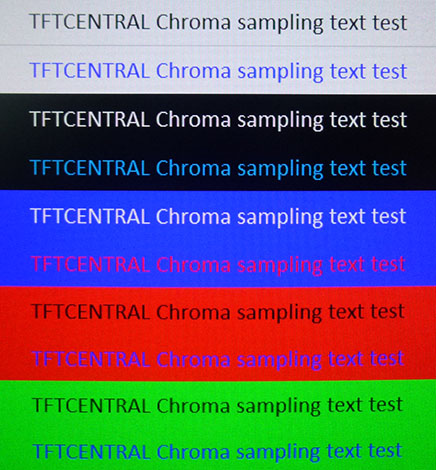
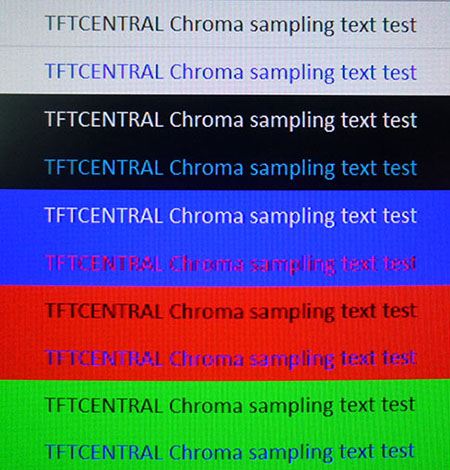
(left) No colour reduction or chroma sub-sampling
(i.e. 4:4:4) vs. 4:2:2
sub-sampling (right)
with size 16 font at 3840 x 2160 resolution
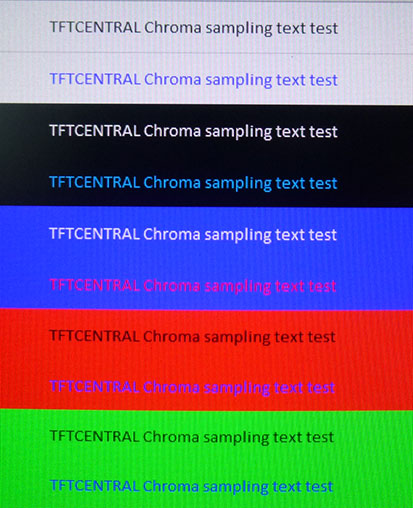

(left) No colour reduction or chroma sub-sampling
(i.e. 4:4:4) vs. 4:2:2
sub-sampling (right)
with size 11 font at 3840 x 2160 resolution
Above are some photos taken in 4:4:4 mode and
4:2:2 mode to give you an idea of the impact the latter has on text clarity. You
can see it mainly impacts text on a coloured background, and where text is
smaller in size. In some samples it's very hard to see any difference to be
honest.
For other uses like movies and games the
difference is far less noticeable. Movies, Blu-rays, external games consoles and
external Blu-ray players are all going to operate at lower refresh rates,
so there is no need to reduce the chroma to 4:2:2 anyway. You might as well run
at 4:4:4 although in many cases it actually has no noticeable benefit over lower
sampling. That's irrelevant here anyway. For gaming, if it's a game with lots of
text you may see some similar problems with text clarity as you would in desktop
use, and as shown above. Otherwise it is hard to notice a difference in many
cases and the advice it to not really worry about it. With the 4K resolution,
high refresh rate and 10-bit colour depth you are probably not
going to worry about any minor drops in colour fidelity we don't think. If the
sub-sampling bothers you then you can easily drop to 8-bit colour depth and
stick to a full 4:4:4 sampling. Or alternatively you can also use the 144Hz
mode...

144Hz Mode

The XV273K can also support a refresh rate of
144Hz if you really want to push the capabilities of your system and be at the bleeding edge of refresh rate and
resolution support in the monitor market. On the first wave of 27" 4K 144Hz
screens like the
Asus ROG Swift PG27UQ that we tested, and Acer's equivalent Predator X27
screen there were some limitations to how 144Hz was used. On those G-sync
enabled screens the 144Hz mode was actually achieved through an overclock
setting in the OSD menu. You had to enable that before you could select 4K @
144Hz in your graphics card control panel. Then, because of the bandwidth
limitations of the DisplayPort 1.4 connection, you had to make some sacrifice to
the colours if you wanted to reach the resolution and refresh rate of 4K @144Hz
that we've talked about above. You always had to drop to 4:2:2 chroma sub-sampling to
use 144Hz on those displays. On the XV273K that is not necessary, and you can
game at 4K @ 144Hz with 10-bit colour and full RGB range (no chroma
sub-sampling)!
This is achieved by connecting two
DisplayPort cables between your graphics card and the screen. The screen has
dual input for DP 1.4 and so you will of course need dual DP 1.4 output from
your graphics card to support this feature. You connect both up to the screen,
and can even use the two provided DP cables in the box. After this you need to
enable the "4K-144Hz" mode in the OSD menu as shown above. Acer refer
to this as an overclock in their documentation, although it's not really
overclocking anything, it's just bonding dual DP 1.4 connections together. The screen quickly
goes blank and then comes back on and
it should then be an available option in the graphics card control panel.
We would recommend using the provided DisplayPort cable, or a high quality cable
to ensure support and stability for 144Hz. We had no issues enabling or using
144Hz from our test system using the provided cable.
By using dual DP
connections the screen can support enough bandwidth to run at these maximum
settings without having to make any colour sacrifices at all. The screen is
still detected in Windows and your graphics card as a single screen as you can
see below. This method of using dual DP connections was not possible on the
first wave of 4K 144Hz displays as they only had a single DP connection due to
the G-sync module limitations. We expect there to be similar limitations with
the forthcoming
Acer Predator XB273K which is basically the G-sync version of this display.
That is almost certainly going to be limited to a single DP connection because
of the G-sync module, and so to reach 144Hz you are likely to need to use chroma
sub-sampling like on the Asus PG27UQ and Acer X27 models. Anyway, on the XV273K
you can use the dual DP connections and not have to sacrifice anything to reach
144Hz at 4K resolution.
It should be noted that you cannot reach
144Hz using only a single DP connection on this screen, even if you attempt to
drop the colour depth or use chroma sub-sampling. Also on another note, when you
enable the 4K-144Hz mode in the menu, it seems to restrict you from then
selecting anything above 120Hz for non-native resolutions like 2560 x 1440.
Update 8/2/19: for clarity as well,
if you run at this 4K-144Hz mode you cannot use FreeSync / G-sync as
the variable refresh rate tech won't work from a dual display output. Also the
HDR mode (which doesn't do much to be honest anyway) isn't available in this
mode.

Once the 4K-144Hz mode is activated on the monitor
and you've connected both DP cables you should see
144Hz listed as an available refresh rate in the graphics card control panel, including
when running at the native 3840 x 2160 resolution. You can see that 10-bit
colour and full RGB range without chroma sub-sampling is selectable here too as
shown above.

After enabling the 4K-144Hz mode via the
OSD menu and making the necessary setting changes in the graphics card control panel we
measured the response times again at the optimal 'extreme' setting for high
refresh rates. At 144Hz there was
a small drop in response times compared with 120Hz, now measured to 6.4ms G2G, from
6.2ms we'd seen at 120Hz. At these levels it still ensured pixel transitions were fast
enough to keep up with the increased frame rate, as they need to be <6.94ms to
keep up at 144Hz. Although the response times had dropped by 0.2ms on average,
the overshoot had also dropped which was very pleasing. There was no real sign
of any overshoot artefacts in practice at 144Hz in the extreme mode.
If you can achieve high refresh rates of 120
- 144Hz on this screen then the 'extreme' overdrive mode will provide the best
experience, with the fastest response times, lowest levels of motion blur and
very little noticeable overshoot. If your refresh rates are going to drop lower
than this, you might start to see overshoot becoming too districting, with pale
halos behind moving objects. This gets worse the lower the refresh rate goes. At
<120Hz we felt the 'normal' mode was optimal on this display.

AMD FreeSync


The presence of AMD FreeSync is very
important on this screen given the huge system demands of powering a screen at
4K resolution. This will dynamically control the refresh rate and remove tearing
and stuttering without any of the added lag that older vsync technology causes.
FreeSync works by synchronizing the display’s refresh interval
with the incoming frame rate, banishing lag and ensuring gameplay stays
smooth even when there are large changes in system rendering times. Its
presence helps eliminate jarring visual artifacts, and even allows a single,
high-performance graphics card to leverage many of the display's benefits.

Update 8/2/19: The XV273K was one of
the first batch of 12 screens certified by NVIDIA as "G-sync Compatible",
meaning that through a driver update in January 2019 compatible graphics cards
will be able to use G-sync variable refresh rates (VRR) from this display,
even though it's not a traditional G-sync screen. So if you're an NVIDIA user,
you will be able to enjoy the VRR support as well, and give you more
flexibility for higher end graphics card choices. We didn't have chance to
test G-sync performance on this screen when we had it with us (before the
announcement and update from NVIDIA) but given it is a proper certified
"G-sync Compatible" display it means it has passed NVIDIA's quality and
performance tests and should work fine. Third party reports of the screen
since also confirm it works well.
The VRR range supported by the screen is 48 - 120/144Hz
but will depend on your resolution. The "overclocked" (as Acer like to refer
to it as) 4K-144Hz mode will not support FreeSync/VRR, as confirmed by the user
manual. It looks like this is a limitation of using a dual DP connection, with
FreeSync only working when powering the screen from a single interface. So if
you're running at 4K resolution you will only be able to use FreeSync between 48
- 120Hz. If you have dropped to a lower resolution, like 2560 x 1440 for
instance, you can run at a refresh rate of up to 144Hz easily, without needing
to use dual DP connections or making any OSD changes. So if you're running at a
lower resolution than the native 4K, the FreeSync range will be 48 - 144Hz.
You need to enable
FreeSync from within the OSD menu to use it, at which point the AMD graphics
card control centre detects the screen as a FS display and allows you to turn it
on. Once enabled as a setting in the OSD menu, the overdrive control actually
becomes locked to the 'normal' mode, so it is not possible to use the 'extreme'
mode if you wanted to. Given that the screen is going to vary the refresh rate
between 48Hz and 120/144Hz, and we know that massive amounts of overshoot are
introduced at the lower refresh rates when using the 'extreme' mode, this is not
really a problem anyway. The 'normal' mode is optimal here and it's good that it
hasn't completely disabled the overdrive. Even if you disable
FreeSync at your graphics card level, the OSD overdrive control still remains
locked to 'normal' unless you disable FreeSync in the monitor OSD menu as well.



(144Hz
measurements for FreeSync only applicable at resolutions below the native 4K)
As you can see, the response time behaviour
when using FreeSync is perhaps opposite to how you might expect. The level of
overdrive applied to the panel is reduced as you increase the refresh
rate. We've seen this behaviour on other FreeSync screens in the past as well,
but you would have thought it would work the other way around. As refresh rate
increases, so too does the frame rate, and so you need to drive the pixels
faster to keep up. On the XV273K it is working in reverse, so response times get
a bit slower as the refresh rate goes up. Not by a massive amount, but they are
getting a little slower with each step. On the flip side this does mean that
the overshoot artefacts are reduced and entirely eliminated by the time you
reach higher refresh rates which is good news.
The net result is that at the top end of the
FreeSync range the response times are a little too slow to properly keep up with
the frame rate demands. You do get a bit of added motion blur and a little dark
smearing in practice on moving content, particularly where content is changing
from black to grey. It was not a major issue and thanks to the high refresh rate
the motion clarity is still very good. It is also not as bad as you would see on
many VA technology panels which have much slower black > grey transitions in
most cases. There is still less black smearing than you'd see from a typical VA
panel. We would have just liked to see slightly faster response times in
this 'normal' overdrive mode to keep up properly with the high refresh rates of
>100Hz. It would have been nice if the overdrive could have been pushed up to
the 'extreme' setting automatically when refresh rates got up to that top end,
but that's obviously not practical. Limiting the overdrive mode to the 'normal'
setting when FreeSync is used is a sensible step and overall the performance was
still a pleasant experience.
If your system is powerful enough to run the
screen at high refresh rates of 120Hz and above (perhaps when running at lower
resolutions), and you don't want to use VRR, or you want to use the
VRB motion blur
reduction mode instead, then you can probably switch up to the 'extreme'
overdrive setting for improved performance. You will need to turn 'FreeSync' off
in the OSD menu to achieve that.

Detailed Response Times
144Hz Refresh Rate, Overdrive = Extreme
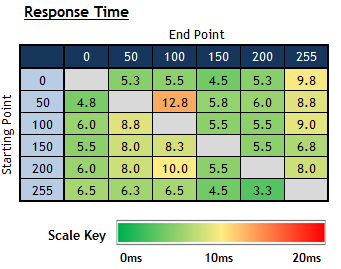
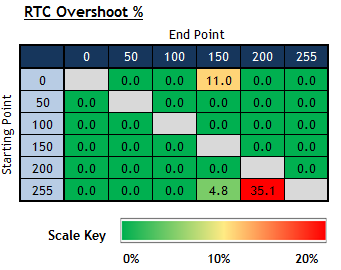
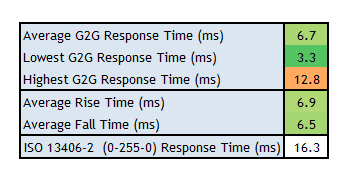
There were lots of different considerations
for gaming depending on your resolution, achievable refresh rate, whether you
want to use FreeSync or not etc. To keep consistent with our other reviews, we
took some further measurements at the settings where response times of the
panel, and the motion clarity in moving content were optimal. This was at the
maximum 144Hz refresh rate and with the overdrive setting on 'extreme' (FreeSync
turned off).
The average G2G
figure was measured at 6.7ms now which was excellent for an IPS-type panel. This
was with very low levels of overshoot that were basically unnoticeable in
practice. The highest level of overshoot was seen on the transition from white
to light grey (255 - 200) which was also the fastest measured response time of
3.3ms, below the 4ms spec even. This screen is more than capable of handling fast paced gaming thanks
to its low response times, high refresh rate and low levels of overshoot. Our
earlier sections talk about variations at 60Hz, with different resolutions and
with FreeSync in use.

Visual Response Boost
(VRB) Blur Reduction Mode
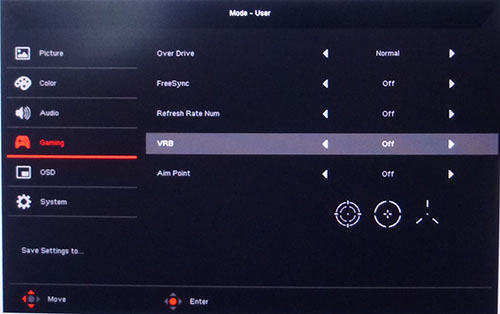
|
Acer have added an strobing blur reduction
backlight to the XV273K via the 'VRB' (Visual Response Boost) setting in the OSD
menu. We've written
an in depth article about these kind of backlights which is worth a read if
you are unfamiliar. The gist of it is that the backlight is strobed off/on very
rapidly in sync with the refresh rate of the display, in order to help reduce
the perceived motion blur in practice. These strobing backlights can work very
well at improving motion clarity and some people really love them. Of course by
enabling the strobing using the VRB mode, you are no longer running with a
flicker free screen, so some people can find it harsh on the eyes. You certainly
wouldn't want to enable these modes for normal day to day use, only for gaming
where any flicker is far less noticeable and where you get the main benefits of
the blur reduction. You cannot use this mode when using AMD FreeSync, so it is
one or the other, as with all other strobed backlights we've seen to date. It
can be used with NVIDIA systems though as it's a monitor feature, not tied to
any specific graphics card choice.
The VRB setting is available in two modes in
the OSD menu, 'normal' and 'extreme'. These each have a preset brightness level
which cannot be altered. If you try to change the brightness control in the menu
it turns VRB back off and reverts you to your previous brightness level. The
extreme mode is darker than the normal mode, but is designed to help try and
improve the motion clarity even further by reducing the strobe "on" time. |
|
Key
Quick Information Box
-
Operates at 120Hz and 144Hz refresh rates only
-
Stick
to 144Hz mode if possible
-
Normal
and extreme modes available but impacts brightness
-
195
cd/m2
maximum brightness is good (normal mode)
-
Good motion blur reduction in
practice, but moderate levels of strobe cross talk
|
|
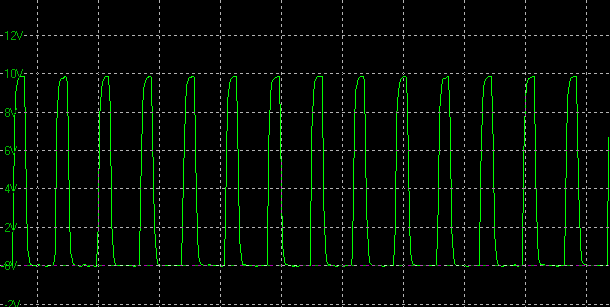
Normal VRB mode at 144Hz operation.
Horizontal scale = 5ms
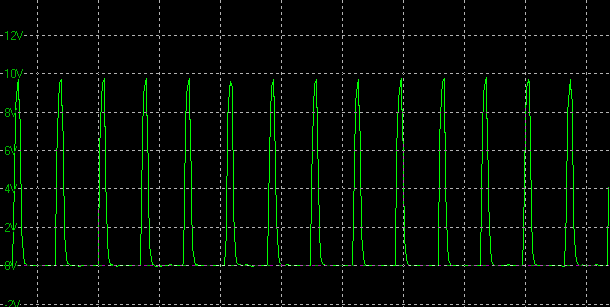
Extreme VRB mode at 144Hz operation.
Horizontal scale = 5ms
The strobing in the VRB mode depends on the
active refresh rate. The mode is available at either 120Hz or 144Hz refresh
rates, regardless of resolution and whether you need to use the 4K-144Hz mode to
reach the maximum resolution at 144Hz. At 144Hz (shown above) the strobing is in
sync with the refresh rate, every 6.94ms. The difference between the normal and
extreme modes relates to the "on" period of the strobe, with the extreme setting
having less "on" time and therefore a darker appearance to the screen. This is
designed to help improve motion clarity even more which we will look at in a
moment. At 120Hz the strobing works but is slightly out of sync with the refresh
rate, strobing every 8.25ms instead of the required 8.33ms.
Brightness Range
|
VRB
Setting |
Luminance
(cd/m2) |
Black
Point (cd/m2) |
Contrast
Ratio
( x:1) |
|
Normal |
195.26 |
0.19 |
1028 |
|
Extreme |
99.63 |
0.09 |
1107 |
We also wanted to test the brightness limit
available when using VRB (at 144Hz in the table above). You can achieve a higher
brightness by running the VRB mode at a lower 120Hz refresh rate but it won't
impact it much. There is no control over the brightness level when using the VRB
setting, other than changing between the normal and extreme modes as we said
before. It was good to be able to reach high brightness levels of close to 200
cd/m2 here, giving users an option if they want brighter gaming with a blur
reduction backlight.
Maximum Blur Reduction Brightness - Display
Comparison
For ease of reference we have
also provided a comparison table below of all the blur reduction enabled
displays we've tested, showing their maximum luminance before blur reduction is
turned on (normal mode) and their maximum luminance with the feature enabled.
This will give you an idea of the maximum brightness you can expect from each
model when using their blur reduction feature, if that is important to you. A
lot of people want a brighter display for gaming and sometimes the relatively
low maximum luminance from blur reduction modes is a limitation.
These comparisons are with the refresh rate as
high as is available for the blur reduction feature to function. For most this
is at 100 - 144Hz. You can achieve a
slightly brighter display if you use the feature at compatible lower refresh
rates since the
strobes are less frequent, but it's not a significant amount. That can also
introduce more visible flicker in some situations.
|
Model |
Refresh Rate |
Max Normal
Luminance
Blur Reduction Off
(cd/m2) |
Max Luminance
Blur Reduction On
(cd/m2) |
|
Acer XB270HU* |
100Hz* |
327 |
111 |
|
Acer Nitro XV273K |
144Hz |
503 |
195 |
|
Acer Predator Z35 |
120Hz |
359 |
111 |
|
Asus ROG Strix XG35VQ |
100Hz |
376 |
164 |
|
Asus ROG Swift PG258Q |
144Hz |
488 |
275 |
|
Asus ROG Swift PG278Q |
120Hz |
385 |
123 |
|
Asus ROG Swift PG279Q |
120Hz |
331 |
101 |
|
BenQ XL2720Z |
144Hz |
282 |
119 |
|
BenQ XL2730Z |
120Hz |
309 |
191 |
|
Dell S2716DG |
120Hz |
328 |
118 |
|
Eizo FG2421 |
120Hz |
386 |
257 |
|
Eizo FS2735 |
144Hz |
331 |
180 |
|
LG 27GK750F |
240Hz |
452 |
199 |
|
LG 34GK950F |
144Hz |
390 |
235 |
|
LG 34UC79G |
144Hz |
267 |
141 |
|
LG 38UC99 |
75Hz |
308 |
213 |
Note:
Pulse Width setting at max where applicable.
*Note 2: The Acer XB270HU was later updated to include a 120Hz mode, which will produce a
slightly darker maximum luminance
Blur Reduction Tests with VRB
Of course the main thing we want to test is what
improvements the Blur Reduction mode offers when it comes to motion clarity and
gaming. We were pleased with the results we'd seen from LightBoost backlights
when we tested them, and also from the natively supported blur reduction
feature on other displays including the other popular gaming models
we've tested.
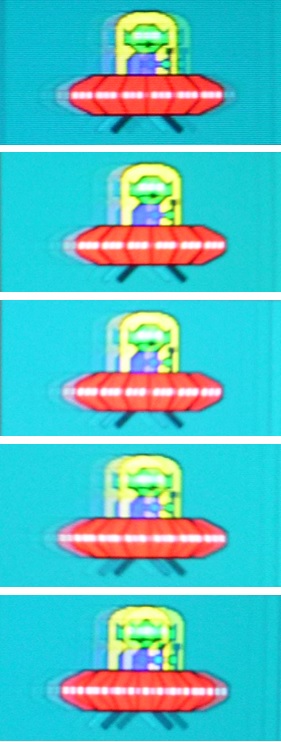
VRB
enabled, upper, middle and lower screen areas of the screen showing cross-talk
We used the BlurBusters full-screen
TestUFO online motion test to put the
feature through its paces. There is a bit of an issue here which was related to
strobe cross talk. The strobe cross
talk is caused by
the timing of the strobe in relation to the refresh rate, and can result in a ghost
image behind the moving object. The above results show the clearest image in the
upper areas of the
screen. Here, the moving UFO object did become sharper and easier to track, and
motion clarity was improved quite nicely compared with standard VRB-off motion
blur tests. However, as you moved down the screen the cross talk and ghosting
became more noticeable. It was moderate in the middle area of the screen which
is perhaps the most important given your focus there in gaming and multimedia.
At the bottom of the screen it was a bit worse still.
You can't eliminate strobe cross talk
completely, but this could have perhaps been tweaked better by Acer to provide a more central area of the screen with the minimal
ghosting, and cut down on some of the more severe examples resulting at the
bottom area of the screen. The 'extreme' mode did help reduce a bit of the
ghosting and cross-talk in practice, but only by a small amount. If you don't
mind the darker image (or prefer it perhaps depending on your ambient light
conditions) then that extreme VRB mode does provide slightly better motion
clarity performance. The ability to use it at lower
refresh rates below 120Hz (even at the risk of visible flickering) may have been useful
to some people but is sadly not possible here.

Gaming Comparisons

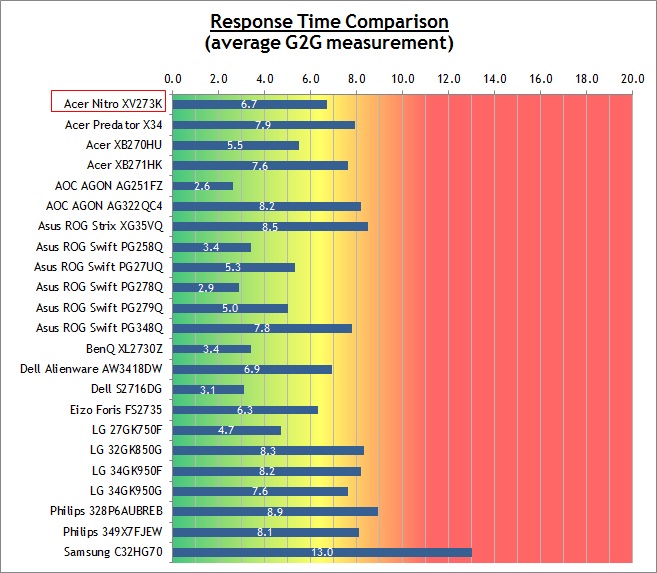
We have provided a comparison of the XV273K against many other screens that we have tested.
The overall responsiveness of the XV273K (6.7ms) was good, and similar to many
of
the other top end high refresh rate IPS panels we've tested. The Asus ROG Swift
PG27UQ (4K @ 144Hz, but with FALD HDR backlight and G-sync) was a bit faster at
5.3ms G2G, as were some of the other 27" high refresh rate IPS screens with
G-sync like the Asus ROG
Swift PG279Q (5.0ms) and Acer Predator XB270HU (5.5ms) for instance. However,
the XV273K was a little faster than some of the 100 - 144Hz IPS panels like the
Acer Predator X34 (7.9ms) and LG 34GK950F (8.2ms) for instance. This was
all with very low levels of overshoot as well which was great news. The TN Film panels here like the Asus ROG Swift
PG278Q (144Hz, 2.9ms) and certainly the PG258Q (240Hz, 3.4ms) could reach a little faster,
although sometimes this is at the expense of some additional moderate levels of
overshoot.

Additional
Gaming Features
-
Aspect Ratio Control -
the screen has 4 options for
hardware level
aspect ratio control
options, with settings for full, aspect, 1:1 pixel mapping and even a 21:9
mode offered.
The aspect mode is really useful as it will maintain the source device aspect
ratio while filling as much of the screen as possible. If you want to directly
map pixels you can use the 1:1 mode as well.
-
Preset Modes -
There are three saveable preset
modes for gaming in the OSD menu, for action, racing and sports. You can
customise your screen settings as you wish and then save them to one of the 3
modes. This seemed to save most settings, although the blur reduction (VRB)
backlight didn't seem to be saveable as a setting, it was a universal on or
off in the menu.


Lag
We have written an in depth article about
input lag and the various measurement techniques which are used to evaluate
this aspect of a display. It's important to first of all understand the
different methods available and also what this lag means to you as an end-user.
Input Lag vs. Display Lag vs. Signal
Processing
To avoid confusion with different terminology
we will refer to this section of our reviews as just "lag" from now on, as there
are a few different aspects to consider, and different interpretations of the
term "input lag". We will consider the following points here as much as
possible. The overall "display lag" is the first, that being the delay between
the image being shown on the TFT display and that being shown on a CRT. This is
what many people will know as input lag and originally was the measure made to
explain why the image is a little behind when using a CRT. The older stopwatch
based methods were the common way to measure this in the past, but through
advanced studies have been shown to be quite inaccurate. As a result, more
advanced tools like SMTT provide a method to measure that delay between a TFT
and CRT while removing the inaccuracies of older stopwatch methods.
In reality that lag / delay is caused by a
combination of two things - the signal processing delay caused by the TFT
electronics / scaler, and the response time of the pixels themselves. Most
"input lag" measurements over the years have always been based on the overall
display lag (signal processing + response time) and indeed the SMTT tool is
based on this visual difference between a CRT and TFT and so measures the
overall display lag. In practice the signal processing is the element which
gives the feel of lag to the user, and the response time of course can
impact blurring, and overall image quality in moving scenes. As people become
more aware of lag as a possible issue, we are of course keen to try and
understand the split between the two as much as possible to give a complete
picture.
The signal processing element within that is
quite hard to identify without extremely high end equipment and very complicated
methods. In fact the studies by Thomas Thiemann which really kicked this whole
thing off were based on equipment worth >100,1000 Euro, requiring extremely high
bandwidths and very complicated methods to trigger the correct behaviour and
accurately measure the signal processing on its own. Other techniques which are
being used since are not conducted by Thomas (he is a freelance writer) or based
on this equipment or technique, and may also be subject to other errors or
inaccuracies based on our conversations with him since. It's very hard as a
result to produce a technique which will measure just the signal processing on
its own unfortunately. Many measurement techniques are also not explained and so
it is important to try and get a picture from various sources if possible to
make an informed judgement about a display overall.
For our tests we will continue to use the
SMTT tool to measure the overall "display lag". From there we can use our
oscilloscope system to measure the response time across a wide range of grey to
grey (G2G) transitions as recorded in our
response time
tests. Since SMTT will not include the full response time within its
measurements, after speaking with Thomas further about the situation we will
subtract half of the average G2G response time from the total display lag. This
should allow us to give a good estimation of how much of the overall lag is
attributable to the signal processing element on its own.
Lag Classification
To help in this section we will also introduce a broader classification system
for these results to help categorise each screen as one of the following levels:
-
Class 1)
Less than 6.94ns / 1 frame lag at 144Hz - should be fine for gamers, even at high
levels
-
Class 2)
A lag of 6.94 -
13.88ms
/ One to two frames at 144Hz - moderate lag but should be fine for many gamers.
Caution advised for serious gaming
-
Class 3)
A lag of more than
13.88ms / more than 2 frames at 144Hz - Some noticeable lag in daily usage, not
suitable for high end gaming

For the full reviews of the
models compared here and the dates they were written (and when screens were
approximately released to the market), please see our
full
reviews index.
|
(Measurements in ms) |
|
|
Total Display Lag (SMTT
2) |
6.40 |
|
Pixel Response Time
Element |
3.35 |
|
Estimated Signal
Processing Lag |
3.05 |
|
Lag Classification |
1 |
|

Class 1 |
We have provided a comparison above against
other models we have tested to give an indication between screens. The screens
tested are split into two measurements which are based on our overall display
lag tests (using SMTT) and half the average G2G response time, as measured by
the oscilloscope. The response time is split from the overall display lag and
shown on the graph as the green bar. From there, the signal processing (red bar)
can be provided as a good estimation.
We measured the total display lag of 6.40ms.
With approximately 3.35ms of that accounted for by pixel response times we had
an estimated signal processing of just 3.05ms, which was next to nothing and in
keeping with other high-end gaming screens we've tested in the past. It was
faster than some other models we've seen in the past with FreeSync as well. This shouldn't
represent any problem for fast paced or competitive gaming.

Movies and Video
The following summarises the screens
performance for videos and movie viewing:
|
Category |
Display
Specs / Measurements |
Comments |
|
Size |
27" widescreen |
Fairly standard for
desktop display today, much smaller than a TV |
|
Aspect Ratio |
16:9 |
Well suited to most
common 16:9 aspect content and input devices |
|
Resolution |
3840 x 2160 |
Can support native 1080p
content and Ultra HD content natively |
|
HDCP |
Yes |
Suitable for encrypted
content across both ports |
|
Connectivity |
DisplayPort 1.4
HDMI 2.0 |
Useful additional HDMI
input for external Blu-ray players or games consoles. Capable of
supporting the high resolution as well |
|
Cables |
DisplayPort only |
HDMI cable is not
provided in the box |
|
Ergonomics |
Tilt, height, swivel |
Good range of
adjustments which are smooth and easy to use. You should be able to position the screen for multiple viewing
positions. |
|
Coating |
Light Anti-glare |
Provides clear,
non-grainy image and avoids unwanted reflections of full glossy solutions |
|
Brightness range |
104 - 503 cd/m2 |
Good adjustment range
offered overall although may be a little limited at the lower end in
darkened room conditions. Flicker free backlight operation with no PWM |
|
Contrast |
1070:1 calibrated |
Strong contrast ratio for
an IPS panel, helping provide good clarity in shadow detail
and darker content. No local dimming supported for improved HDR contrast
ratios sadly. |
|
Preset modes |
None specific |
No specific modes for
movies or video, but you can easily create and save one to one of the 3
gaming preset modes |
|
Response times |
6.7ms G2G at 144Hz, low
overshoot
8.1ms G2G at 60Hz with low/moderate overshoot |
Very good overall and
more than fine for movie viewing certainly. Stick with the 'Normal' response
time setting if running at 60Hz or for external devices. |
|
Viewing angles |
Very good |
Thanks to the IPS panel
technology, suitable for viewing from a wide range of positions.
Usual pale/white glow on dark content because of the typical IPS panel. |
|
Backlight bleed |
Very good |
No backlight bleed on our
sample (may vary) which is good, as that can be particularly problematic
on movies with black borders. |
|
Audio |
2x 4W speakers
Headphone jack |
Basic integrated speakers
may be ok for the odd video clip and a headphone jack available also. |
|
Aspect Ratio Controls |
1:1, Aspect, Full, 21:9
mode |
Good options to account
for non-native format inputs if needed |
|
PiP / PbP |
Not available |
n/a |
|
HDR support |
VESA Display HDR 400
certified
No real support |
Despite the somewhat
misleading VESA Display HDR 400 specification, there is no only limited HDR
support from this screen. The main gripe with the VESA Display HDR 400
certified screens when it comes to HDR is that there is no local dimming to support
improvements in the dynamic range.
There is however an increased peak brightness
offered of around 500 cd/m2 which is beyond the capabilities of many
screens (typically 250 - 350 cd/m2). There is also a boost in colour space thanks
to the 97.5% DCI-P3 gamut offered from the backlight which helps improve
the vividness of colours and meet the requirements of HDR content which is
mastered typically in the DCI-P3 colour space.
Update 8/2/19: for
clarity, you cannot use the screen in HDR mode if you also enable
FreeSync/G-sync, they do not work together at any refresh rate. |

Conclusion
We spend a massive amount
of time producing these detailed reviews, and this one seems to be even bigger
than normal! Loads to test and plenty of exciting and interesting things to look
at. If you appreciate and enjoy our reviews, and would like to help
support
TFTCentral we really
appreciate it.
It is really great to see new options
emerging for 4K @ 144Hz gaming displays, considering that the first wave were
extremely expensive. Sure, the high end FALD HDR backlights have been dropped to
make that possible, but it does open up the market for those who aren't as
bothered about HDR right now, and just want to enjoy the high refresh rate and
high resolution combination. The 4K panel provides a very high level of detail
here, even at a relatively small 27" screen size. You're going to need a very
powerful system to run this display, but the high refresh rates bring smooth and
fluid gaming, with improved motion clarity compared with the previous range of
60Hz-only screens. It's useful to see AMD FreeSync included here and even the
new NVIDIA G-sync Compatible certification, and it's
actually the first 4K @ 144Hz display to offer FreeSync instead of only G-sync which
is bound to be of interest to AMD users. That technology will help your system
cope with the demands of this screen nicely. The response times were very good
from the panel as well, although they could have been slightly faster at the
very top end when using the 'normal' response time mode, which you are
restricted to if you're using FreeSync as well. Still, they were good enough to
offer a god motion performance across the range. Acer have introduced a clever
way of supporting 4K @ 144Hz without the need for any colour sacrifices,
although it is a bit of a shame that you can't reach 144Hz when using FreeSync/G-sync.
Achieving high refresh rates around 144Hz without VRR does afford you the
chance to push the overdrive setting and offer the absolute optimal experience
but might be a challenge for many systems right now.
In other gaming considerations the screen had
a very low lag which was excellent news, and not always the case for FreeSync
displays. The added motion blur reduction backlight (VRB) option will be of
interest to some people for sure. You get a nice boost in colours from the wider
colour space, and there's also a fair few extras and OSD options available to
enhance the experience.
Away from gaming we were impressed with the
screen in other areas too. The IPS-panel offers strong all round performance
with wide viewing angles and a stable image. The default setup was good and the
factory calibrated sRGB mode was even better. It was nice to see options to run
the screen either with the full native DCI-P3 gamut or sRGB if you wanted here.
The screen was a little limited when it came to minimum brightness adjustments
so if you use your PC in dark conditions a lot it might be a little too bright
for some. The OSD was annoying and slow to use, but that's our only significant
gripe really with the XV273K.
If you are keen to enter the world of 4k @
144Hz but don't want to fork out for the top of the range HDR-capable models
like the Predator X27, then the arrival of the XV273K (and soon XB273K with
G-sync) will be music to your ears. The performance and features was impressive
and the new lower pricing makes them an attractive option.
|
Pros |
Cons |
|
4K @ 144Hz gaming for the
first time with AMD FreeSync support and at more affordable prices |
Sluggish OSD controls |
|
Good response times, very
low lag, high refresh rates and even an added strobing backlight motion
blur reduction mode make it great for gaming |
Limited minimum
brightness levels |
|
Good factory calibration
and sRGB emulation mode available |
Response times could have
been a little better at high refresh rate end when using VRR |
|
Check Pricing and Buy -
Affiliate Links
|
|
Amazon
|
|
TFTCentral is a participant
in the Amazon Services LLC Associates Programme, an affiliate
advertising programme designed to provide a means for sites to earn
advertising fees by advertising and linking to Amazon.com, Amazon.co.uk,
Amazon.de, Amazon.ca and other Amazon stores worldwide. We also
participate in a similar scheme for Overclockers.co.uk. |
|

|
TFT Central Awards Explained
We have two award
classifications as part of our reviews. There's the top 'Recommended'
award, where a monitor is excellent and highly recommended by us. There is
also an 'Approved' award for a very good screen which may not be perfect,
but is still a very good display. These awards won't be given out every
time, but look out for the logo at the bottom of the conclusion. A list of
monitors which have won our awards is available
here. |